Home — Essay Samples — Life — Who Am I — Who Am I: Creative Writing

Who Am I: Creative Writing
- Categories: About Myself Who Am I
About this sample

Words: 1040 |
Updated: 21 November, 2023
Words: 1040 | Pages: 2 | 6 min read
Table of contents
Prompt examples for the "who am i" essays, "who am i" essay examples.
- Self-Reflection and Identity Explore the concept of self-reflection and the journey to discovering one's identity. How has self-awareness evolved throughout your life, and what factors have contributed to your understanding of who you are?
- Emotions and Self-Perception Discuss your emotional landscape and its impact on your self-perception. How do you experience and express emotions? How do they shape your self-image and interactions with others?
- Self-Esteem and Self-Obsession Examine the dynamics of self-esteem and self-obsession in your life. How has your self-esteem evolved over time, and how does it relate to your self-obsession or self-care? Share personal experiences that illustrate this evolution.
- Social Interactions and Introversion Reflect on your social interactions and introverted tendencies. How do you navigate social situations, and what happens when you step out of your comfort zone? Discuss the balance between introversion and extroversion in your life.
- Leadership and Taking Charge Describe your experiences with leadership and taking charge in various situations. How do you approach leadership roles, and what qualities make you effective in these roles? Share examples of when you've assumed leadership and its impact on those around you.
Who am I: Creative Essay
Works cited.
- Akhtar, S., & Akhtar, F. (2016). A critical study of self-concept and self-esteem. Journal of Humanities and Social Science, 21(7), 15-22.
- Benson, K. (2007). The power of personality types in career success. Journal of Employment Counseling, 44(3), 98-104.
- Cassidy, S., & Eachus, P. (2002). Developing the computer user self-efficacy (CUSE) scale: Investigating the relationship between computer self-efficacy, gender and experience with computers. Journal of Educational Computing Research, 26(2), 133-153.
- Costa, P. T., & McCrae, R. R. (1992). Revised NEO Personality Inventory (NEO-PI-R) and NEO Five-Factor Inventory (NEO-FFI) professional manual. Psychological Assessment Resources.
- Deci, E. L., & Ryan, R. M. (2008). Self-determination theory: A macrotheory of human motivation, development, and health. Canadian Psychology/Psychologie canadienne, 49(3), 182-185.
- Friedman, H. S. (2010). Personality, disease, and self-healing: An integrative perspective. The Journal of Alternative and Complementary Medicine, 16(1), 5-9.
- Howard, L. W., & Ferris, G. R. (1996). The employment interview context: Social and situational influences on interviewer decisions. Journal of Applied Social Psychology, 26(24), 2153-2174.
- McAdams, D. P. (1993). The stories we live by: Personal myths and the making of the self. Guilford Press.
- Swami, V. (2008). The influence of body weight on self-perceptions and partner preferences. Sex Roles, 58(9-10), 651-654.
- Tversky, A., & Kahneman, D. (1974). Judgment under uncertainty: Heuristics and biases. Science, 185(4157), 1124-1131.
Video Version

Cite this Essay
Let us write you an essay from scratch
- 450+ experts on 30 subjects ready to help
- Custom essay delivered in as few as 3 hours
Get high-quality help

Verified writer
- Expert in: Life

+ 120 experts online
By clicking “Check Writers’ Offers”, you agree to our terms of service and privacy policy . We’ll occasionally send you promo and account related email
No need to pay just yet!
Related Essays
2 pages / 723 words
2 pages / 732 words
1 pages / 514 words
2 pages / 1064 words
Remember! This is just a sample.
You can get your custom paper by one of our expert writers.
121 writers online
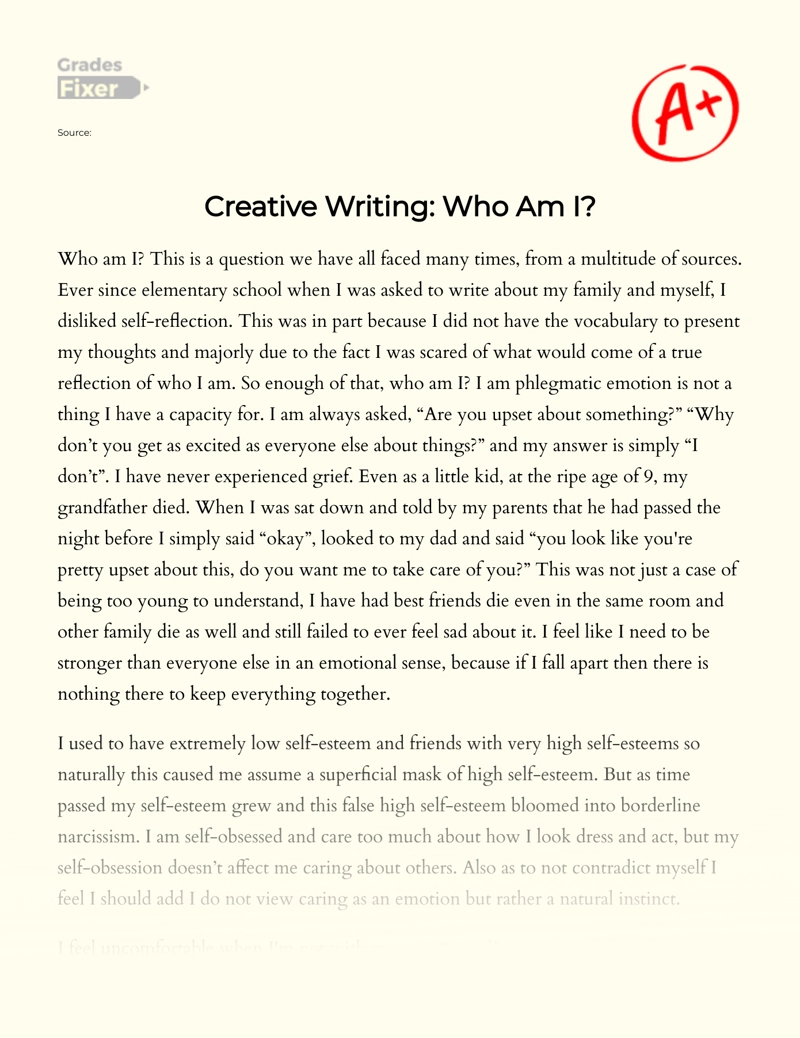
Still can’t find what you need?
Browse our vast selection of original essay samples, each expertly formatted and styled
Related Essays on Who Am I
What makes me who I am? This question has lingered in my mind for as long as I can remember. As I delve into the complexities of my personality, I am met with a tapestry of traits, experiences, and beliefs that have shaped me [...]
In weaving the meaning of my name into the fabric of my identity, I reflect upon the deliberations my parents underwent upon my arrival into this world. When I was born, my parents couldn’t decide on what to name me – my dad [...]
Who am I? For my essay, I would normally start off by listing my age, nationality, religious belief, what school I attend, what I do for a living and so on. But does that truly define who I am? Once I sat and started thinking [...]
Have you ever wondered what makes you, you? In today's fast-paced world, understanding our own personalities can provide valuable insights into our behavior, relationships, and career choices. In this essay, I will delve into [...]
The person I am today is the result of a complex interplay between life experiences, relationships, and inherent traits. By reflecting on the impact of significant life events, challenges, and accomplishments on my personal [...]
Have you ever wondered what makes a writer unique? As I delve into the exploration of who I am as a writer, I invite you to join me on a journey of self-discovery and reflection. Through this essay, I will delve into the various [...]
Related Topics
By clicking “Send”, you agree to our Terms of service and Privacy statement . We will occasionally send you account related emails.
Where do you want us to send this sample?
By clicking “Continue”, you agree to our terms of service and privacy policy.
Be careful. This essay is not unique
This essay was donated by a student and is likely to have been used and submitted before
Download this Sample
Free samples may contain mistakes and not unique parts
Sorry, we could not paraphrase this essay. Our professional writers can rewrite it and get you a unique paper.
Please check your inbox.
We can write you a custom essay that will follow your exact instructions and meet the deadlines. Let's fix your grades together!
Get Your Personalized Essay in 3 Hours or Less!
We use cookies to personalyze your web-site experience. By continuing we’ll assume you board with our cookie policy .
- Instructions Followed To The Letter
- Deadlines Met At Every Stage
- Unique And Plagiarism Free
How to Write a Creative Essay: Your Fresh Guide

What Is a Creative Essay
In a world full of logic, facts, and statistics, being able to unleash your true creativity might seem like a fresh breath of air. Sometimes, all we need is to shut our minds, let our thoughts flow through, and immerse ourselves in endless imagination. To think about it, being able to let your imagination run wild yields something genuinely exceptional, an outcome that is not restricted to mundane reality which eventually opens a whole new universe of broadened horizons.
Now, imagine that you can bring together your unique thoughts onto a piece of paper and organize them in a specific format, so when one reads through it, one can easily follow your points while simultaneously being captured by your set of perspectives. Notice how there is an intersection between creativity and organization? These two do not have to be mutually exclusive. That's why in this article we intend to explain how you can put your creative thoughts into words, arrange these words into paragraphs and finally structure these paragraphs in a well-defined creative essay outline.
Now that we have your undivided attention let us briefly explain what is a creative essay and what kind of assignment it represents when you're given one. A creative essay is more than just throwing words on paper to reach a certain character limit. Such an essay assesses your ability to discover and clarify notions to your audience. In academic writing, creative essays can provide you the chance to showcase your research ability together with your vocabulary and composition skills.
Nearly all educational levels, including universities, need students to produce creative essays. When picking creative essay topics, you often have great flexibility. Your professor may give you a subject or category to specialize in, but you are allowed to choose any concept as long as it fits the specified area.
While having the flexibility to write about whatever you want is fantastic, the thought may also be somewhat intimidating. So, read on to get the key tips on how to write a creative essay, along with a step-by-step guide in the following paragraphs.
And if you ever pondered how to write in cursive , we've got you covered on that too!
Helpful Tips for Writing a Creative Essay

In case you were wondering, yes, there are some tactics for writing a creative essay that you may employ. Therefore let our college essay writer provide you with the following useful advice to make your creative essay examples more intriguing and unique:
- Start Off Strong: Using an attention-grabbing introduction is a common piece of creative writing advice. One approach to achieve this is to open the narrative with a retrospect, which might throw off the timeline by bringing the audience back into the heart of the scene at the very start of the narrative.
- Employ an Outline: Make an outline after you have a topic. Consider your favorite book by your favorite creator. Does it follow a clear framework? A solid start, body, and closing? Very likely, it does, and your essay needs to reflect that. Therefore, before beginning, devote some time to developing a creative writing essay outline.
- Take Risks: Do it without hesitation. Often, writings that take chances and push limits end up being the most impactful. Don't be shy to experiment with different writing styles, a unique writing tone, or a subject that causes you to feel uneasy. Present your own ideas and allow them to make a statement.
- Use Descriptive Language : Provide descriptive elements that show off your vocabulary to help others understand your creative essay ideas. Writing creatively is all about illuminating a scene with phrases. Employ descriptive words to evoke strong mental images in your audience. To assist your reader in visualizing the situation you're portraying, include sensory information such as vision, sound, flavor, sensation, and scent.
- Use Extended Metaphors: An extended metaphor strategy is frequently used in creative writing. It could be better to use an analogy to communicate the idea by making parallels, which people find simpler to grasp than to struggle through attempting to lay out a difficult topic in a basic manner.
- Edit Extensively: Few succeed on the first try. When you've finished the initial version, go back and review it to see whether your arguments are in the best sequence and if your writing truly stands to reason. In the era of technology, it's simple to cut and paste sections of your essay into where they would suit better to help your essay flow smoother. Remove everything that doesn't support your essay's main idea or topic.
How to Write a Creative Essay: Breaking Down a Creative Essay Outline
Apart from the tips above, you might need a step-by-step guide demonstrating essential writing steps. While creative essays adhere to an outline much like other types of essays, such as book review format , they use a slightly different framework known as the 3-Point Structure. This involves: The Setup -> Confrontation -> Resolution. Let's break down each component below:

- Set Up: Generally stated in the introduction, the setup establishes the characters and their connection with one another. What are the predefined links between the main members? Give the readers enough information to begin making assumptions about how the narrative will evolve.
- Confrontation: Written in the body, the narrative must have a Defining Moment. At this conflicting point, the calm sea becomes a violent storm. This turn of events could be foreshadowed by the plot's hints, or it might just happen out of nowhere. Your decision as the author will determine your actions. For instance, you can start implying that the storyline seems strange before returning to normal without making significant changes. Alternatively, the narrative can be moving along without incident when a significant event occurs, abruptly changing the course of the story.
- Resolution: After the story's pivotal moment, the drama will have intensified and gradually subsided. There will eventually come a time when the tension picks back up and reaches a pinnacle. Now, this could either be revealed at the end of the narrative (a cliffhanger) or disclosed anywhere between the middle and the beginning. This also depends on you as the author.
Creative Essay Introduction
Establishing the scene in a creative essay opening is the first thing to be done in any storytelling. Provide a brief description of the area, the period of the day, and the history of the present situation. This opening setting is key because it establishes the atmosphere and flow of the whole storyline. Having said that, be sure to enliven the scene as much as possible to let the reader see it perfectly. Employ explicit descriptions; poetic devices, analogies, and symbols are excellent ways to change the tone of the text right away.
Creative Essay Body
The bodies are employed to advance the storyline and convey the message. But you may also employ these sections to switch up the motion and emotion. For instance, as the author, you may include the conflict immediately if the plot progresses slowly. The reader is taken aback by this, which alters the narrative’s tone and pace. Also, you might stage a phony conflict to keep your audience on edge.
Creative Essay Conclusion
Usually, the creative writers may wrap up the narrative in the end. Set up a conflict, then give the resolution to wind up the conversation. Most of the time, the ending won't lead to the story's climax, but many expert writers employ cliffhangers. Using such creative essay writing techniques, the reader might be kept in a state of suspense without revealing what happened to the characters.
Creative Essay Topics and Ideas
Before putting yourself into creative essay writing, you should pick among creative writing essays topics that you will be talking about. Here we got some fresh creative essay topics from our top college essay writer to make your choice easier:
- Explain an event in your life that spiraled out of control and flipped its course.
- Create a scenario that directs the end of the world.
- Camouflage the concept of love in a story that is completely irrelevant.
- Design in a story in which one person's beliefs or ideas helped reform the future of society.
- Propose a scenario in the distant future in which technology controls all.
- Describe something that you can't live without; it might be your hobby or a thing that you are dedicated to.
- Express your thoughts about a topic that hurts you.
- Imagine that you became invisible for one day. What would you do?
- What would your reaction be if one day you woke up in someone else's body
Naturally, you can create one that is completely unique to you and the ideas that you form. These creative writing topics are here to get you started on the right path towards a brilliant story.

Creative College Essay Topics
Now that our coursework writers guided your curiosity through different creative writing tips and writing structure, you might fancy some topics for creative nonfiction essay to give you a more clear idea. Let us walk you through some inspirational creative essay titles:
- 'Being My True-Self in Solitude' - Describe when you were completely alone and what lessons you took from it. Here you can examine the notion of isolation and how it may inspire your creativity. You can also discuss a solo excursion you undertook, a moment when you felt abandoned, or a period when you deliberately sought solitude to contemplate and refresh.
- 'My Life's Soundtrack' - Talk about your favorite song or a piece of music that sums up your character or reflects your life. Your essay might examine a specific line of lyrics that speaks to your life experience. You can also describe how the beats and rhythm highlight a particular memory or challenge you overcame.
- 'Dear Future Me' - In this essay letter, you can converse with your future self in 10 years. First, talk about your present self, what you're grateful for, and what you wish would go differently in the future. Ask your older self questions about how things have changed over these years, and reflect upon your main aspirations.
- 'My Perfect Imperfections' - Recall a moment when you acknowledge your weaknesses or flaws. Appreciate the thought that imperfections are a normal and lovely aspect of human existence. You may also discuss overcoming self-doubt or a physical trait you used to detest but have come to adore.
Need Some Creative Writing Help?
Choose your personal paper writer on our service and check it out!
Example of a Creative Essay
Aldrine was already hitting his mid-30’s and the pressure from parents and peers was building up fast. While he admitted that marriage was an essential rite of passage, he was also keen not to marry an entirely incompatible partner with whom he would struggle all through adulthood. The father was already losing patience and several of his peers had been sent with threats that he would eventually be ostracized.
Did you like it? You can also buy essays online from us, and our authors will write it flawlessly and within the stipulated time frame. You can also read an article about book review format , there you will also find useful information.
Wrapping Up
As we come to an end, we hope you gained a clear insight into what is creative essay and how to write it. Some people will always find it simpler to write creative essays than others. Yet, by putting the tips above into practice, you should be in a strong position to generate work that you're happy with.
You could be left-brained, more comfortable with analytical thought processes than with eloquent language. In this case, you may embark on a journey with the help of our qualified paper writer team, who has produced a ton of creative college essay topics. We know that every creative essay is different, and each of our writers can vividly depict a scene that will astound you. Have some doubts? Buy essays online today and be assured of our promise!
Are You Short on Creative Writing Topics?
Whether you need a compelling personal statement, a thought-provoking argumentative essay, or a captivating narrative, we've got you covered.
FAQs on Creative Essay Writing
If you feel like some questions were left unanswered, don't you feel disappointed just yet! Our dissertation writers for hire compiled the most frequently asked question on creative essay writing, so take a look for additional information:
What Are the 7 Types of Creative Writing?
What are the 5 c's of creative writing, is creative writing a skill, related articles.
%20(2).webp)
How to Write a Creative Essay: Useful Tips and Examples
%20(1).webp)
Essay creative writing is not always seen as fun by most students, but the realm of creative essays can offer an enjoyable twist. The inherent freedom in choosing a topic and expressing your thoughts makes this type of paper a creative playground. Engaging in composing a creative essay provides an opportunity to flex your creative muscles. Yet, if you're new to crafting compositions, it can pose a challenge. This article guides you through the steps to write an impressive creative essay, helping you navigate the process seamlessly. In a hurry? Our writing service is there for you 24/7, with guidance and practical help.
What Is a Creative Essay
A creative essay is a form of writing that goes beyond traditional academic structures, allowing the author to express themselves more imaginatively and artistically. Unlike formal essays, creative ones emphasize storytelling, personal reflection, and the exploration of emotions. They often incorporate literary elements such as vivid descriptions, dialogue, and poetic language to engage readers on a more emotional and sensory level. Follow our creative essay tips to experiment with style and structure, offering a unique platform to convey ideas, experiences, or perspectives in a captivating and inventive way.
To answer the question what does creative writing mean, it’s necessary to point out that it departs from traditional academic writing, offering a canvas for artistic expression and storytelling. It diverges from the rigid structure of formal writings, providing a platform for writers to infuse their work with imagination and emotion. In this genre, literary elements such as vivid descriptions and poetic language take center stage, fostering a more engaging and personal connection with the reader.
Unlike a poem analysis essay , this form of writing prioritizes narrative and self-expression, allowing authors to delve into their experiences and perspectives uniquely. It's a departure from the conventional rules, encouraging experimentation with style and structure. Creative essays offer a distinct avenue for individuals to convey ideas and emotions, weaving a tapestry that captivates and resonates with readers on a deeper, more sensory level.

Creative Writing Essay Outline Explained From A to Z
Moving on, let's delve into how to write a creative writing essay from s structural perspective. Despite the focus on creativity and imagination, a robust structure remains essential. Consider your favorite novel – does it not follow a well-defined beginning, middle, and end? So does your article. Before diving in, invest some time crafting a solid plan for your creative writing essay.
.webp)
Creative Essay Introduction
In creative essay writing, the introduction demands setting the scene effectively. Begin with a concise portrayal of the surroundings, the time of day, and the historical context of the present scenario. This initial backdrop holds significant weight, shaping the atmosphere and trajectory of the entire storyline. Ensure a vivid depiction, employing explicit descriptions, poetic devices, analogies, and symbols to alter the text's tone promptly.
Creative Essay Body
The body sections serve as the engine to propel the storyline and convey the intended message. Yet, they can also be leveraged to introduce shifts in motion and emotion. For example, as creative writers, injecting conflict right away can be a powerful move if the plot unfolds slowly. This unexpected twist startles the reader, fundamentally altering the narrative's tone and pace. Additionally, orchestrating a fabricated conflict can keep the audience on edge, adding an extra layer of intrigue.
Creative Essay Conclusion
Typically, creative writers conclude the narrative towards the end. Introduce a conflict and then provide its resolution to tie up the discourse neatly. While the conclusion often doesn't lead to the story's climax, skilled writers frequently deploy cliffhangers. By employing these writing techniques, the reader is left in suspense, eagerly anticipating the fate of the characters without a premature revelation.
Creative Writing Tips
Every student possesses a distinct mindset, individual way of thinking, and unique ideas. However, considering the academic nature of creative writing essays, it is essential to incorporate characteristics commonly expected in such works, such as:
.webp)
- Select a topic that sparks your interest or explores unique perspectives. A captivating subject sets the stage for an engaging paper.
- Begin with a vivid and attention-grabbing introduction. Use descriptive language, anecdotes, or thought-provoking questions to draw in your readers from the start.
- Clearly articulate the main idea or theme of your essay in a concise thesis statement. This provides a roadmap for your readers and keeps your writing focused.
- Use descriptive language to create a sensory experience for your readers. Appeal to sight, sound, touch, taste, and smell to enhance the imagery.
- Play with the structure of your content. Consider nonlinear narratives, flashbacks, or unconventional timelines to add an element of surprise and creativity.
- If applicable, develop well-rounded and relatable characters. Provide details that breathe life into your characters and make them memorable to the reader.
- Establish a vivid and immersive setting for your narrative. The environment should contribute to the overall mood and tone.
- Blend dialogue and narration effectively. Dialogue adds authenticity and allows characters to express themselves, while narration provides context and insight.
- Revisit your essay for revisions. Pay attention to the flow, coherence, and pacing. Edit for clarity and refine your language to ensure every word serves a purpose.
- Share your creative writing article with others and welcome constructive feedback. Fresh perspectives can help you identify areas for improvement and refine your storytelling.
- Maintain an authentic voice throughout your essay. Let your unique style and perspective shine through, creating a genuine connection with your audience.
- Craft a memorable conclusion that leaves a lasting impression. Summarize key points, evoke emotions, or pose thought-provoking questions to resonate with your readers.
Types of Creative Writing Essays
A creative writing essay may come in various forms, each offering a unique approach to storytelling and self-expression. Some common types include:
- Reflects the author's personal experiences, emotions, and insights, often weaving in anecdotes and reflections.
Descriptive
- Focuses on creating a vivid and sensory-rich portrayal of a scene, person, or event through detailed descriptions.
- Tells a compelling story with a clear plot, characters, and often a central theme or message.
Reflective
- Encourages introspection and thoughtful examination of personal experiences, revealing personal growth and lessons learned.
Expository
- Explores and explains a particular topic, idea, or concept creatively and engagingly.
Persuasive
- Utilizes creative elements to persuade the reader to adopt a particular viewpoint or take a specific action.
Imaginative
- These creative writing papers allow for the free expression of imagination, often incorporating elements of fantasy, surrealism, or speculative fiction.
Literary Analysis
- Learning how to write a creative writing essay, analyze and interpret a piece of literature, and incorporate creativity to explore deeper meanings and connections.
- Blends personal experiences with travel narratives, offering insights into different cultures, places, and adventures.
- Focuses on creating a detailed and engaging portrait of a person, exploring their character, experiences, and impact on others.
Experimental
- Pushes the boundaries of traditional essay structures, experimenting with form, style, and narrative techniques.
- Combines elements from different essay types, allowing for a flexible and creative approach to storytelling.
As you can see, there are many types of creative compositions, so we recommend that you study how to write an academic essay with the help of our extensive guide.
How to Start a Creative Writing Essay
Starting a creative writing essay involves capturing the reader's attention and setting the tone for the narrative. Here are some effective ways to begin:
- Pose a thought-provoking question that intrigues the reader and encourages them to contemplate the topic.
- Begin with a short anecdote or a brief storytelling snippet that introduces the central theme or idea of your essay.
- Paint a vivid picture of the setting using descriptive language, setting the stage for the events or emotions to unfold.
- Open with a compelling dialogue that sparks interest or introduces key characters, immediately engaging the reader in the conversation.
- Incorporate a relevant quotation or epigraph that sets the mood or provides insight into the essay's theme.
- Begin with a bold or intriguing statement that captivates the reader's attention, encouraging them to delve further into your essay.
- Present a contradiction or unexpected scenario that creates a sense of curiosity and compels the reader to explore the resolution.
- Employ a striking metaphor or simile that immediately draws connections and conveys the essence of your creative essay.
- Start by directly addressing the reader, creating a sense of intimacy and involvement right from the beginning.
- Establish the mood or atmosphere of your essay by describing the emotions, sounds, or surroundings relevant to the narrative.
- Present a dilemma or conflict that hints at the central tension of your essay, enticing the reader to discover the resolution.
- Start in the middle of the action, dropping the reader into a pivotal moment that sparks curiosity about what happened before and what will unfold.
Choose an approach to how to write a creative essay that aligns with your tone and theme, ensuring a captivating and memorable introduction.
Creative Essay Formats
Working on a creative writing essay offers a canvas for writers to express themselves in various formats, each contributing a unique flavor to the storytelling. One prevalent format is personal writing, where writers delve into their own experiences, emotions, and reflections, creating a deeply personal narrative that resonates with readers. Through anecdotes, insights, and introspection, personal essays provide a window into the author's inner world, fostering a connection through shared vulnerabilities and authentic storytelling.
Another captivating format is the narrative, which unfolds like a traditional story with characters, a plot, and a clear arc. Writers craft a compelling narrative, often with a central theme or message, engaging readers in a journey of discovery. Through vivid descriptions and well-developed characters, narrative articles allow for the exploration of universal truths within the context of a captivating storyline, leaving a lasting impression on the audience.
For those who seek to blend fact and fiction, the imaginative format opens the door to vivid exploration. This format allows writers to unleash their imagination, incorporating elements of fantasy, surrealism, or speculative fiction. By bending reality and weaving imaginative threads into the narrative, writers can transport readers to otherworldly realms or offer fresh perspectives on familiar themes. The imaginative essay format invites readers to embrace the unexpected, challenging conventional boundaries and stimulating creativity in both the writer and the audience. Check out our poetry analysis essay guide to learn more about the freedom of creativity learners can adopt while working on assignments.
Creative Essay Topics and Ideas
As you become familiar with creative writing tips, we’d like to share several amazing topic examples that might help you get out of writer’s block:
- The enchanted garden tells a tale of blooms and whispers.
- Lost in time, a journey through historical echoes unfolds.
- Whispering winds unravel the secrets of nature.
- The silent symphony explores the soul of music.
- Portraits of the invisible capture the essence of emotions.
- Beyond the horizon is a cosmic adventure in stardust.
- Can dreams shape reality? An exploration of the power of imagination.
- The forgotten key unlocks doors to the past.
- Ripples in the void, an exploration of cosmic mysteries.
- Echoes of eternity are stories written in the stars.
- In the shadow of giants, unveils the unsung heroes.
- Can words paint pictures? An exploration of the artistry of literary expression.
- Whispers of the deep explore the ocean's hidden stories.
- Threads of time weave lives through generations.
- Do colors hold emotions? A journey of painting the canvas of feelings.
- The quantum quandary navigates the world of subatomic particles.
- Reflections in a mirror unmask the layers of identity.
- The art of silence crafts narratives without words.
- The ethereal dance explores movement beyond the visible.
- Can shadows speak? Unveiling stories cast in darkness.
Examples of Creative Writing Essays
We've added a couple of brief creative writing essays examples for your reference and inspiration.
Creative Writing Example 1: Admission Essay
Creative writing example 2: narrative essay.

What Are the Types of Creative Writing Essays?
What is a creative writing essay, how to start a creative writing essay, what are some creative writing tips.

- Plagiarism Report
- Unlimited Revisions
- 24/7 Support
📕 Studying HQ
Creative writing essays: tips, examples, and strategies, carla johnson.
- June 14, 2023
- Essay Topics and Ideas , How to Guides
Creative writing essays are a unique type of academic writing that lets you show your creativity and imagination while still following the rules of academic writing. Creative writing essays are not like other types of essays that rely heavily on research and facts. Instead, they depend on your ability to tell a story, create vivid images, and make your readers feel something.
Writing creatively is important for anyone who wants to express themselves in a unique and interesting way, not just fiction and poetry writers. Whether you are writing a personal essay , a descriptive essay, or an argumentative essay, adding creative elements can help make your writing more interesting and memorable.
In this article, we’ll talk about what to do and what not to do when writing a creative essay . We’ll look at tips, examples, and ways to write well. By following these rules, you can learn how to write creatively while still meeting the requirements of academic writing.
What You'll Learn
Understanding Creative Writing Essays
To write a good creative writing essay, you need to know how this unique type of academic writing works.
A creative writing essay is a type of academic essay that uses elements of creative writing, like telling a story, building characters, and using literary devices. The goal of a creative writing essay is to get the reader’s attention and hold it while still getting the message or argument across.
There are different kinds of creative writing essays, such as personal essays, essays that describe something, and essays that tell a story . Each of these types of essays needs a different way of writing them, but they all need to include creative elements.
Dos of Creative Writing Essays
Here are some dos of creative writing essays to keep in mind when writing:
1. Choosing a strong and interesting topic: Choose a topic that is interesting to you and that will engage your readers. This will help to keep your writing focused and engaging.
2. Developing a clear and engaging thesis statement: Your thesis statement should clearly convey the message or argument you are making in your essay . It should be engaging and capture the reader’s attention.
3. Creating well-rounded and dynamic characters: Characters are an important part of any creative writing essay. Develop characters that are well-rounded and dynamic, with their own unique personalities, motivations, and flaws.
4. Using sensory details to enhance the story: Sensory details, such as sights, sounds, smells, tastes, and textures, can help to bring yourwriting to life and create a more immersive experience for your readers. Use vivid and descriptive language to evoke the senses and create a more vivid world for your readers to imagine.
5. Incorporating dialogue effectively: Dialogue can be a powerful tool for conveying information and developing characters. Use dialogue to reveal character traits, advance the plot, and create tension.
6. Utilizing literary devices to enhance the story: Literary devices like metaphors, similes, symbols, and images can make a story more interesting and help the reader understand it better. Use these tools sparingly and on purpose to make your effect stronger.
By using these dos in your creative writing essay, you can make it more interesting, easy to remember, and effective.
To write a good creative writing essay, you need to use your imagination, skills, and knowledge. By learning the basics of this unique type of writing and following the dos in this article, you can make a more interesting and effective creative writing essay. Remember to pick a strong and interesting topic, make characters that are well-rounded, use details and dialogue well, and use literary devices to make the story better.
Don’ts of Creative Writing Essays
To avoid common pitfalls when writing a creative writing essay, here are some don’ts to keep in mind:
1. Overusing adjectives and adverbs: While descriptive language is important in creative writing, overusing adjectives and adverbs can make your writing feel cluttered and overwhelming.
2. Using cliches and predictable plot lines: Creative writing is all about bringing something new and fresh to the table. Using cliches and predictable plot lines can make your writing feel unoriginal and uninspired.
3. Writing flat and uninteresting characters: Characters are an important part of any creative writing essay. Flat and uninteresting characters can make your writing feel dull and unengaging.
4. Forgetting to revise and edit: Like any form of academic writing, it is important to revise and edit your creative writing essay to ensure that it is polished and error-free.
5. Using weak verbs and passive voice: Weak verbs and passive voice can make your writing feel flat and uninteresting. Use strong and active verbs to create a more dynamic and engaging narrative.
Inspiring Creative Writing Essay Examples
To gain a better understanding of what makes a successful creative writing essay, here are some inspiring examples to analyze:
1. The Yellow Wallpaper” by Charlotte Perkins Gilman
2. “The Tell-Tale Heart” by Edgar Allan Poe
3. “The Lottery” by Shirley Jackson
4. “A Good Man is Hard to Find”by Flannery O’Connor
5. “The Cask of Amontillado” by Edgar Allan Poe
6. “The Secret Life of Walter Mitty” by James Thurber
7. “The Garden Party” by Katherine Mansfield
8. The Road Not Taken” by Robert Frost
9. The Love Song of J . Alfred Prufrock” by T.S. Eliot
10. “To His Coy Mistress” by Andrew Marvell
By looking at these examples, you can see that symbolism, foreshadowing, and irony are often used in creative writing essays that work well. They also have well-thought-out characters, interesting plots, and language that evokes the senses and helps the reader picture a vivid world.
Each of these examples shows a different side of what it means to be human and helps us learn more about the world around us. These essays show how creative writing can captivate and interest readers, whether it’s about love, death, or what it’s like to be human.
Some of the most important things to learn from these examples are how important it is to have strong characters, use descriptive language well, and use literary devices to make the story better. By looking at these good examples of creative writing essays, writers can learn how to use the same techniques in their own work to make essays that are more interesting and effective.
How to Start a Creative Writing Essay with a Bang
Starting a creative writing essay in a way that captivates your reader is crucial for the success of your essay. Here are some different strategies you can use to start your essay with a bang:
1. Using attention-grabbing hooks to draw in the reader: Start with a provocative statement, a surprising fact, or a rhetorical question to pique the reader’s interest.
2. Crafting a strong opening sentence or paragraph: Create a vivid image or use descriptive language to set the scene and draw the reader into the story.
3. Starting in the middle of the action: Begin your story in the middle of a dramatic or exciting scene to immediately engage your reader.
4. Using an anecdote: Start with a personal anecdote that relates to the theme or message of your essay to draw the reader into your story.
By using attention-grabbing hooks and crafting a strong opening sentence or paragraph, you can hook your reader from the beginning and keep them engaged throughout your essay.
Elements of a Successful Creative Writing Essay
To write a successful creative writing essay, it is important to incorporate certain elements into your writing. Here are some elements to keep in mind:
1. Developing a strong plot and narrative structure: Your essay should have a clear beginning, middle, and end, with a well-developed plot that keeps the reader engaged.
2. Creating compelling and relatable characters: Your characters should be well-rounded, withunique personalities, motivations, and flaws that make them relatable and interesting to the reader.
3. Using descriptive language and sensory details: Use vivid and sensory language to create a world that the reader can imagine and visualize. This can enhance the reading experience and make your writing feel more immersive.
4. Incorporating dialogue and literary devices effectively: Dialogue can be a powerful tool for conveying information and developing characters. Literary devices like metaphor, simile, and symbolism can also be used to enhance the story and create deeper meaning.
5. Crafting a satisfying ending : Your essay should have a satisfying and conclusive ending that ties up loose ends and leaves a lasting impression on the reader.
To write a good creative writing essay, you need to use your imagination, skills, and knowledge. Use hooks and a strong first sentence or paragraph to get people interested in your essay right away. To make sure your story is successful, include things like a strong plot and story structure, interesting characters, descriptive language and sensory details, good dialogue and literary devices, and a satisfying ending. With these tips and elements in mind, you can write a powerful and memorable creative writing essay that engages and inspires your readers.
Creative Writing Essay Format
When it comes to formatting a creative writing essay, there are a few guidelines to keep in mind:
1. Use a standard font, such as Times New Roman or Arial, in 12-point size.
2. Double-space the text and use 1-inch margins on all sides.
3. Include a header with your name, the title of your essay , and the page number.
4. Use paragraph breaks to separate different ideas or sections of your essay .
5. Use italics or quotation marks to indicate dialogue or emphasize certain words or phrases.
Proper formatting is important to ensure that your work looks professional and is easy to read. By following these guidelines, you can create a polished and well-formatted creative writing essay.
When organizing and structuring your essay , consider using a clear and logical structure. This can include an introduction, body paragraphs, and a conclusion. You may also want to use headings and subheadings to break up your writing into sections and make it easier to follow.
Creative Writing Essay Topics
Generating creative writing essay topics can be a fun and creative process. Here are some brainstorming techniques and examples to help you come up with ideas:
Brainstorming Techniques:
1. Freewriting: Set a timer for 10-15 minutes and write down whatever comes to mind. Don’t worry about grammar or spelling, just write freely.
2. Mind Mapping: Start with a central idea and branch out with related ideas. This can help you visualize connections between ideas and spark new ones.
3. Listing: Make a list of words or phrases that relate to a central theme or idea. This can help you see patterns and connections between ideas.
Examples of Creative Writing Essay Topics:
1. A childhood memory that shaped who you are today.
2. A personal essay about overcoming a challenge.
3. A fictional story set in a dystopian society.
4. A character study of a family member or friend .
5. A descriptive essay about a memorable place .
6. An exploration of a unique hobby or interest.
7. A persuasive essay about a social or political issue .
8. A narrative essay about a journey or adventure .
9. A creative nonfiction essay about a historical event or person.
10. A personal essay about your relationship with nature .
11. A fictional story about a time traveler.
12. An essay about a defining moment in your life .
13. A character study of a famous historical figure .
14. A descriptive essay about a favoritefood or dish.
15. A personal essay about your experience with mental health .
16. A fictional story about a haunted house.
17. A persuasive essay about the importance of education .
18. A narrative essay about a difficult decision you had to make.
19. A creative nonfiction essay about a place that has special meaning to you.
20. A personal essay about your experience with a different culture.
21. A fictional story about a person with a superpower.
22. A character study of a famous author or artist.
23. A descriptive essay about your favorite season.
24. A persuasive essay about the benefits of exercise.
25. A narrative essay about a trip that changed your perspective.
26. A creative nonfiction essay about your first job .
27. A personal essay about your experience with discrimination .
28. A fictional story about a post-apocalyptic world.
29. A character study of a famous musician or athlete.
30. A descriptive essay about a favorite childhood memory.
It is important to choose a topic that is both interesting and manageable. Consider your interests and passions, as well as the audience you are writing for. Remember that a well-chosen topic can make your writing more engaging and effective, while also making the writing process more enjoyable and fulfilling.
Tips for Making Your Creative Writing Essay Interesting
– Using descriptive language and sensory details
– Incorporating conflict and tension into the story
– Developing complex and dynamic characters
– Using humor, irony, or suspense to engage the reader
To make your creative writing essay interesting and engaging, consider the following tips:
1. Use descriptive language and sensory details: Creating a vivid world for the reader to imagine can enhance the reading experience and make your writing more immersive.
2. Incorporate conflict and tension into the story: Conflict drives the narrative forward and creates tension that keeps the reader engaged.
3. Develop complex and dynamic characters: Characters with unique personalities, motivations, and flaws can make your story more relatable and interesting.
4. Use humor, irony, or suspense to engage the reader: Adding a touch of humor, irony, or suspense can make your writing more engaging and keep the reader hooked.
By using these techniques, you can make your creative writing essay more interesting and memorable for your readers.
Revision and Editing Tips for Creative Writing Essays
Revision and editing are important steps in the writing process. Here are some tips for revising and editing your creative writing essay:
1. Take a break: Step away from your writing for a few hours or days to gain a fresh perspective on your work .
2. Read your work out loud: This can help you catch errors and awkward phrasing that may not be immediately apparent when reading silently.
3. Get feedback from others: Share your work with others and ask for constructive criticism and feedback.
4. Look for common mistakes: Pay attention to common mistakes such as grammar and spelling errors, repetition, and inconsistencies.
5.Focus on clarity and conciseness: Ensure that your writing is clear and concise, and that your ideas are presented in a logical and organized manner.
6. Make sure your characters are consistent: Ensure that your characters’ actions, motivations, and personalities are consistent throughout the story.
7. Cut unnecessary words and phrases: Eliminate unnecessary words and phrases to tighten your writing and make it more impactful.
8. Check for pacing: Ensure that your story is paced well and that it moves at a pace that keeps the reader engaged.
9. Pay attention to the ending: Ensure that your ending is satisfying and that it ties up loose ends in a way that leaves a lasting impression on the reader.
By revising and editing your creative writing essay, you can improve the overall quality of your work and ensure that it is polished and error-free.
Frequently Asked Questions
1. what is a creative writing essay.
A creative writing essay is a type of essay that allows writers to express their creativity and imagination. It can take many forms, including personal essays , short stories, poetry, and more.
2. What are the elements of a creative writing essay?
The elements of a creative writing essay include a strong plot and narrative structure, compelling and relatable characters, descriptive language and sensory details, effective use of dialogue and literary devices, and a satisfying ending.
3. How do I make my creative writing essay interesting?
You can make your creative writing essay interesting by using descriptive language and sensory details, incorporating conflict and tension into the story, developing complex and dynamic characters, and using humor, irony, or suspense to engage the reader.
4. What is the best way to start a creative writing essay?
You can start a creative writing essay with a provocative statement, a surprising fact, or a rhetorical question to pique the reader’s interest. Alternatively, you can create a vivid image or use descriptive language to set the scene and draw the reader into the story.
5. How can I revise and edit my creative writing essay effectively?
To revise and edit your creative writing essay effectively, take a break, read your work out loud, get feedback from others, look for common mistakes, focus on clarity and conciseness, ensure consistency in character development, cut unnecessary words and phrases, check for pacing, and pay attention to the ending.
In conclusion, a creative writing essay is a powerful way to express your creativity and imagination. By incorporating the elements of a strong plot and narrative structure, compelling characters, descriptive language and sensory details, effective use of dialogue and literary devices, and a satisfying ending, you can create a memorable and impactful piece of writing. To make your essay interesting , consider using descriptive language, incorporating conflict and tension, developing complex characters, and using humor, irony, or suspense. When revising and editing your essay, take a break, read your work out loud, get feedback, and pay attention to common mistakes.
We encourage you to start your own creative writing essay and explore the many possibilities that this type of writing offers. Remember to choose a topic that is both interesting and manageable, and to let your creativity and imagination shine through in your writing. With these tips and techniques in mind, you can create a powerful and memorable creative writing essay that engages and inspires your readers.
Start by filling this short order form order.studyinghq.com
And then follow the progressive flow.
Having an issue, chat with us here
Cathy, CS.
New Concept ? Let a subject expert write your paper for You
Have a subject expert write for you now, have a subject expert finish your paper for you, edit my paper for me, have an expert write your dissertation's chapter, popular topics.
Business StudyingHq Essay Topics and Ideas How to Guides Samples
- Nursing Solutions
- Study Guides
- Free Study Database for Essays
- Privacy Policy
- Writing Service
- Discounts / Offers
Study Hub:
- Studying Blog
- Topic Ideas
- How to Guides
- Business Studying
- Nursing Studying
- Literature and English Studying
Writing Tools
- Citation Generator
- Topic Generator
- Paraphrasing Tool
- Conclusion Maker
- Research Title Generator
- Thesis Statement Generator
- Summarizing Tool
- Terms and Conditions
- Confidentiality Policy
- Cookies Policy
- Refund and Revision Policy
Our samples and other types of content are meant for research and reference purposes only. We are strongly against plagiarism and academic dishonesty.
Contact Us:
📞 +15512677917
2012-2024 © studyinghq.com. All rights reserved
Bookings Open for Online Summer Courses

Showcasing Personal Voice and Style
When writing your creative essay, try to showcase your unique voice by being authentic and as original as you can. It can also be fun to experiment with style.
Change up your sentence structures!
Use new and bold words, and create exciting rhythms!
If you have a distinct personal voice, your work will be sure to stand out.
“Incorporating some dialogue can also be a good way to draw readers in.”
“You should try to use varying sentence lengths as well.”
“Definitely!”
Overall, the most important thing to showcase when writing a creative essay is allowing your individuality to shine through. Write in a way that is bold and different, and show the reader what makes you stand out as a writer.
Editing and Revising
Once you’ve finished writing your creative essay, your work isn’t finished! Editing and revising are both really important elements of the creative process. Try reading your piece aloud to gain a new perspective on the flow of your sentences, and seek feedback from others. Don’t forget to also check for any grammar and spelling errors that you may have missed during the writing process.
Multiple rounds of revision can help to refine the essay and enhance its overall impact. This means that you don’t have to be nitpicky or pedantic when you write your first draft; you’re free to express your ideas creatively and messily. Then you can put on your editing hat. Reread, rewrite and correct as much as you can until you are left with your masterpiece!
Writing creative essays should be fun and enjoyable. It’s a great way to embrace your creativity and experiment with different writing techniques. If you want to practise your essay-writing skills, you can take part in the OxBright essay competition to showcase your skills!

Looking to improve your creative writing?
Recommended articles

OxBright Tutors Share Their Top Tips for High School Graduates
Finishing high school can be a really intimidating juncture – you’re leaving the security of a routine you’ve followed for five plus years, and you’re faced with more options and less structure than ever before. Oh, and your decisions now can shape your future in a...
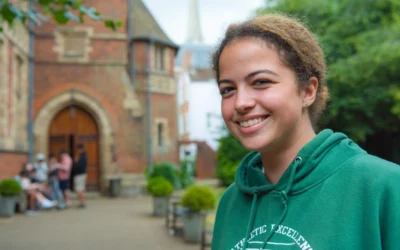
Which Career Is the Best Fit for Me?
Choosing your career path is one of the first big steps you’ll take as a young adult, so it can often be a daunting prospect. However, the possibilities are endless, and as long as you base your choices on your personal preferences, passions and interests, your...

How to Make a Study Schedule That Actually Works
Studying can sometimes feel like a daunting task, no matter how old you are or what level you’re studying at. You might be left thinking: How can I balance academics with my other commitments? How do I stay consistent with a study schedule? Is there a “good” or...
How to Write the Perfect Essay
06 Feb, 2024 | Blog Articles , English Language Articles , Get the Edge , Humanities Articles , Writing Articles

You can keep adding to this plan, crossing bits out and linking the different bubbles when you spot connections between them. Even though you won’t have time to make a detailed plan under exam conditions, it can be helpful to draft a brief one, including a few key words, so that you don’t panic and go off topic when writing your essay.
If you don’t like the mind map format, there are plenty of others to choose from: you could make a table, a flowchart, or simply a list of bullet points.
Discover More
Thanks for signing up, step 2: have a clear structure.
Think about this while you’re planning: your essay is like an argument or a speech. It needs to have a logical structure, with all your points coming together to answer the question.
Start with the basics! It’s best to choose a few major points which will become your main paragraphs. Three main paragraphs is a good number for an exam essay, since you’ll be under time pressure.
If you agree with the question overall, it can be helpful to organise your points in the following pattern:
- YES (agreement with the question)
- AND (another YES point)
- BUT (disagreement or complication)
If you disagree with the question overall, try:
- AND (another BUT point)
For example, you could structure the Of Mice and Men sample question, “To what extent is Curley’s wife portrayed as a victim in Of Mice and Men ?”, as follows:
- YES (descriptions of her appearance)
- AND (other people’s attitudes towards her)
- BUT (her position as the only woman on the ranch gives her power as she uses her femininity to her advantage)
If you wanted to write a longer essay, you could include additional paragraphs under the YES/AND categories, perhaps discussing the ways in which Curley’s wife reveals her vulnerability and insecurities, and shares her dreams with the other characters. Alternatively, you could also lengthen your essay by including another BUT paragraph about her cruel and manipulative streak.
Of course, this is not necessarily the only right way to answer this essay question – as long as you back up your points with evidence from the text, you can take any standpoint that makes sense.

Step 3: Back up your points with well-analysed quotations
You wouldn’t write a scientific report without including evidence to support your findings, so why should it be any different with an essay? Even though you aren’t strictly required to substantiate every single point you make with a quotation, there’s no harm in trying.
A close reading of your quotations can enrich your appreciation of the question and will be sure to impress examiners. When selecting the best quotations to use in your essay, keep an eye out for specific literary techniques. For example, you could highlight Curley’s wife’s use of a rhetorical question when she says, a”n’ what am I doin’? Standin’ here talking to a bunch of bindle stiffs.” This might look like:
The rhetorical question “an’ what am I doin’?” signifies that Curley’s wife is very insecure; she seems to be questioning her own life choices. Moreover, she does not expect anyone to respond to her question, highlighting her loneliness and isolation on the ranch.
Other literary techniques to look out for include:
- Tricolon – a group of three words or phrases placed close together for emphasis
- Tautology – using different words that mean the same thing: e.g. “frightening” and “terrifying”
- Parallelism – ABAB structure, often signifying movement from one concept to another
- Chiasmus – ABBA structure, drawing attention to a phrase
- Polysyndeton – many conjunctions in a sentence
- Asyndeton – lack of conjunctions, which can speed up the pace of a sentence
- Polyptoton – using the same word in different forms for emphasis: e.g. “done” and “doing”
- Alliteration – repetition of the same sound, including assonance (similar vowel sounds), plosive alliteration (“b”, “d” and “p” sounds) and sibilance (“s” sounds)
- Anaphora – repetition of words, often used to emphasise a particular point
Don’t worry if you can’t locate all of these literary devices in the work you’re analysing. You can also discuss more obvious techniques, like metaphor, simile and onomatopoeia. It’s not a problem if you can’t remember all the long names; it’s far more important to be able to confidently explain the effects of each technique and highlight its relevance to the question.

Step 4: Be creative and original throughout
Anyone can write an essay using the tips above, but the thing that really makes it “perfect” is your own unique take on the topic. If you’ve noticed something intriguing or unusual in your reading, point it out – if you find it interesting, chances are the examiner will too!
Creative writing and essay writing are more closely linked than you might imagine. Keep the idea that you’re writing a speech or argument in mind, and you’re guaranteed to grab your reader’s attention.
It’s important to set out your line of argument in your introduction, introducing your main points and the general direction your essay will take, but don’t forget to keep something back for the conclusion, too. Yes, you need to summarise your main points, but if you’re just repeating the things you said in your introduction, the body of the essay is rendered pointless.
Think of your conclusion as the climax of your speech, the bit everything else has been leading up to, rather than the boring plenary at the end of the interesting stuff.
To return to Of Mice and Men once more, here’s an example of the ideal difference between an introduction and a conclusion:
Introduction
In John Steinbeck’s Of Mice and Men , Curley’s wife is portrayed as an ambiguous character. She could be viewed either as a cruel, seductive temptress or a lonely woman who is a victim of her society’s attitudes. Though she does seem to wield a form of sexual power, it is clear that Curley’s wife is largely a victim. This interpretation is supported by Steinbeck’s description of her appearance, other people’s attitudes, her dreams, and her evident loneliness and insecurity.
Overall, it is clear that Curley’s wife is a victim and is portrayed as such throughout the novel in the descriptions of her appearance, her dreams, other people’s judgemental attitudes, and her loneliness and insecurities. However, a character who was a victim and nothing else would be one-dimensional and Curley’s wife is not. Although she suffers in many ways, she is shown to assert herself through the manipulation of her femininity – a small rebellion against the victimisation she experiences.
Both refer back consistently to the question and summarise the essay’s main points. However, the conclusion adds something new which has been established in the main body of the essay and complicates the simple summary which is found in the introduction.

Hannah is an undergraduate English student at Somerville College, University of Oxford, and has a particular interest in postcolonial literature and the Gothic. She thinks literature is a crucial way of developing empathy and learning about the wider world. When she isn’t writing about 17th-century court masques, she enjoys acting, travelling and creative writing.
Recommended articles

A Day in the Life of an Oxford Scholastica Student: The First Monday
Hello, I’m Abaigeal or Abby for short, and I attended Oxford Scholastica’s residential summer school as a Discover Business student. During the Business course, I studied various topics across the large spectrum that is the world of business, including supply and...

Mastering Writing Competitions: Insider Tips from a Two-Time Winner
I’m Costas, a third-year History and Spanish student at the University of Oxford. During my time in secondary school and sixth form, I participated in various writing competitions, and I was able to win two of them (the national ISMLA Original Writing Competition and...

Beyond the Bar: 15 Must-Read Books for Future Lawyers
Reading within and around your subject, widely and in depth, is one of the most important things you can do to prepare yourself for a future in Law. So, we’ve put together a list of essential books to include on your reading list as a prospective or current Law...
Places on our 2024 summer school are filling fast. Don’t miss out. Enrol now to avoid disappointment
- 7 Techniques from Creative Writing You Can Use to Improve Your Essays

You wouldn’t have thought that essays have much in common with creative writing.
You should also read…
- How to Improve Your English Writing Skills
- How to Write Dazzlingly Brilliant Essays
Creative writing, by definition, involves being ‘creative’: making things up, letting your imagination run wild. Essays are about being factual and objective, communicating ideas and arguments in the clearest way possible and attempting to enhance the reader’s knowledge, rather than their imagination. But while the literary devices and colourful tales we associate with creative writing are indeed out of place in an essay, these two very different kinds of writing actually have a few similarities. Above all, they’re both meant to be read by other people, and that means that they need to sustain the reader’s interest. So, are there any writing techniques you can borrow from creative writing to help make your essays more interesting and original? Yes there are, and in this article, we’re going to show you how. Before we start, if you’re interested in attending a summer school to help develop these skills , click the link.
1. Think about your reader
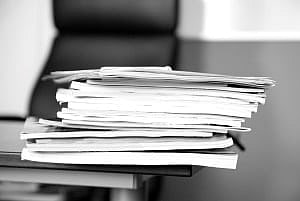
With creative writing, as with any kind of writing, your reader is your most important consideration. You need to know and understand whom you’re writing for if you’re to do a good job of keeping them interested. Let’s think for a moment about the kind of person you’re writing for when you’re writing an essay and what you need to do to write specifically for them:
- Teachers or university lecturers – they’re going to be marking your essay, so it needs to answer the question effectively.
- They’ve set the question and they probably have a pretty good idea of how you’re going to answer it – so be original and unpredictable; catch them by surprise with an unusual approach or structure.
- They’re going to be reading many other responses to the same question – so they may well be bored by the time they get to yours. Keep them interested!
- They’re probably going to be pressed for time – so they won’t have time to reread badly written passages to try to understand what you’re getting at. Keep your writing easy to read, succinct and to the point.
What all these points boil down to is the importance of keeping your reader interested in what you have to say. Since creative writing is all about holding the reader’s interest, there must be some lessons to be learned from it and techniques that can be applied within the more limited style constraints of the academic essay. We’ll now turn to what these are.
2. Three-act structure

The three-act structure is a writing device used extensively in modern writing, including for film and television dramas. These ‘acts’ aren’t as distinct as acts in a play, as one follows seamlessly on from another and the audience wouldn’t consciously realise that one act had ended and another began. The structure refers to a plotline that looks something like this:
- Set-up – establishes the characters, how they relate to each other, and the world they inhabit. Within this first ‘act’, a dramatic occurrence called an ‘inciting incident’ takes place (typically around 19 minutes into a film) involving the principal character. They try to deal with it, but this results in another dramatic occurrence called a ‘turning point’. This sets the scene for the rest of the story.
- Confrontation – the turning point in the previous ‘act’ becomes the central problem, which the main character attempts to resolve – usually with plenty of adversity thrown their way that hampers their efforts. In a murder mystery, for example, this act would involve the detective trying to solve the murder. The central character – with the help of supporting characters – undergoes a journey and develops their knowledge, skills or character to a sufficient degree to be able to overcome the problem.
- Resolution – the climax of the story, in which the drama reaches a peak, the problem is overcome, and loose ends are tied up.
This structure sounds all very well for made-up stories, but what has it got to do with essay-writing? The key similarities here are:
- The central argument of your essay is the equivalent of the main character.
- The essay equivalent of the set-up and resolution are the introduction and conclusion.
- The inciting incident in an essay encourages you to get to the point early on in the essay.
- The equivalent of character development in the second act is developing your argument.
- The equivalent of the supporting characters is the evidence you refer to in your essay.
So, applying the three-act structure to an essay gives you something like this:
- Set-up – the introduction. This establishes what you’re talking about, setting the scene. The ‘inciting incident’ could be the introduction of evidence that contradicts a common theory, or the highlighting of a central disagreement in how something is interpreted.
- Confrontation – you discuss the different problems surrounding the topic you’re writing about. You develop the argument using various bits of evidence, moving towards an overall conclusion.
- Resolution – the conclusion. You summarise and resolve the argument with your own opinion, by coming down on one side or the other, having weighed up the evidence you’ve discussed. You could perhaps tie up loose ends by offering an alternative explanation for evidence that doesn’t sit with your conclusion.
Using this structure keeps you focused on the central point, and stops you from waffling, because everything you write is working towards resolving your argument. The use of the inciting incident in the first ‘act’ encourages you to get to the point early on in your essay, thereby keeping the reader interested. The principles of good plot-writing are centred around the connection between different events that show cause and effect, and this central tenet of the three-act structure has obvious parallels with the way in which essays work through presenting evidence in support of arguments.
3. An attention-grabbing opening

An oft-spouted piece of advice in creative writing is to use an attention-grabbing opening. One way of doing this is to start with a ‘flashback’, which could disrupt the chronology of events by transporting the reader directly back to the midst of the action, so that the story begins with maximum excitement. In a murder mystery, for instance, the writer might skip a slow build-up and instead use the murder itself to form the opening of the novel, with the rest of the story charting the efforts of the detective to uncover the perpetrator and perhaps telling the events prior to the murder in a series of flashbacks. The same principle can be applied to essays, though it’s easier to use in some subjects than others. To take an example, let’s say you were writing about how the First World War started. Rather than building up slowly with the various factors, an attention-grabbing opening could (briefly) describe the drama of the Battle of the Somme, perhaps citing some statistics about the number of men involved and killed, and quoting some war poetry about the horrors faced by the soldiers on the Front Line. Then, to introduce the purpose of the essay and launch into your argument about what started the war, a phrase such as, “It seems hard to imagine that all this began with…”. Alternatively, a rhetorical question: “But how did these tens of thousands of soldiers end up in the mud and horror of trench warfare? The story begins several years earlier, with…” It may not be the standard way of writing an essay, but you’ll certainly score points for originality and perhaps ruffle a few feathers.
4. Extended metaphors

Creative writing often makes use of extended metaphors. For example, when Shakespeare wrote the passage in Romeo and Juliet referring to “It is the East, and Juliet is the sun!” he was using an extended metaphor. With this in mind, it’s time to revisit a point we made in a previous article about writing more original essays , in which we argued that, rather than battling on with trying to explain a complex concept in a straightforward way, it might be easier to use an analogy to convey the meaning by drawing comparisons, which people find easier to understand. A metaphor is a kind of analogy, so the similarities with creative writing are strong here. In our previous article we used the example of radioactive decay. An analogy for this is the pressure with which water escapes from a hole in a bucket. It does so exponentially, just as radioactive substances decay exponentially. In both instances, the rate of a consumptive process depends on how much there is left of whatever is being depleted, which results in an exponential rate of decay. This concept is so much easier to explain using the analogy of water flowing from a hole in a bucket, as you give your reader something familiar to visualise in order to explain a concept with which they are unfamiliar.
5. Interesting details about setting and location

Another way of keeping your reader interested is to bring your essay to life with details about setting and location, just as creative writers do. Essays can become quite dry if you focus solely on the academic problems, but you can make them more interesting by peppering them with details. This may not work quite so well for a scientific essay, but it’s certainly relevant for some humanities subjects, in particular English literature, history and archaeology. For example, an essay about the Roman emperor Augustus could mention that he lived a famously modest lifestyle, quoting details from Roman writers and archaeological evidence that support this: Suetonius mentions his “low bed” (interesting because of what it says about accepted standards of Roman beds!) and coarse bread and cheese diet, and the relatively small and non-lavish remains of his house on the Palatine Hill in Rome back up the idea of his having lived a modest life. Incidental details like these can actually prove to be more significant than you initially realise, and you can use them to build your argument; in the case of Augustus, for example, his modest lifestyle is particularly important when seen in the context of Rome’s troubled history with kings. As he gradually acquired more power and became Rome’s first emperor, he had to avoid coming across as being too ‘regal’, and the little details we know about his way of life are significant in light of this. So, not only have you brought your essay to life, but you’ve raised an interesting point, too.
Few writers get it right first time . Once you’ve written a first draft, read through it and think about whether the order of your points is optimal and whether what you’ve written actually makes sense. It’s easy in the age of computers to chop and change – you can simply copy and paste part of your essay into another part where it might fit better, and then make minor changes to your wording so that it flows. After you’ve finished editing, have a final read through and check that you’re happy with the wording. Don’t forget to proofread to ensure that your spelling and grammar is impeccable!
7. And finally… record your ideas

Creative writers swear by having a notebook with them at all times, ready to jot down any ideas that suddenly spring to mind. You can adopt the same principle for your essay-writing, because you never know when the inspiration might strike. Have a think about your essay topic when you’re out and about; you’d be surprised what occurs to you when you’re away from your normal place of study. As you can see, there are more similarities between two apparently unrelated kinds of writing than you might have realised. It is, of course, possible to go too far with the creative writing idea when you’re essay-writing: literary devices aren’t always appropriate, and your essay still needs to retain objectivity and conform to the more formal conventions of academic writing. But there are certainly techniques to be borrowed from creative writing that will help your essays stand out from the crowd and give your teacher or lecturer a welcome break from the monotony of essay-marking.
See also our fabulous guide explaining more about ” What is Creative Writing ”.
Comments are closed.
How to Write a Creative Essay | 07 Techniques, Types & features
A creative essay is a form of writing that blends imagination with storytelling, allowing writers to express themselves in a unique and artistic way. How to Write a Creative Essay is a common question in literature;

Table of Contents
How to Write a Creative Essay
Understanding the essay prompt and coming up with ideas are the first steps in writing a creative essay. To keep focused and arrange your thoughts, create an outline for your essay.
Throughout the writing process, stay true to your own voice and style, and carefully edit your essay for impact and clarity.
Types of Creative Essays Source
1. personal essay.
An autobiographical piece that delves into a specific experience or subject from the writer’s life is called a personal essay. It frequently considers one’s own emotions, ideas, and revelations.
Personal essays can address a variety of topics, such as relationships or particular occurrences, as well as personal development and reflection.
By sharing their own viewpoints and experiences, writers can establish a personal connection with readers through this kind of essay writing.

A memoir is a type of autobiographical writing that concentrates on a particular time or event in the writer’s life, much like a personal essay. Memoirs, on the other hand, are usually more organized and concentrated, frequently according to a timeline.
Memoirs can give readers more in-depth understanding of the author’s life and experiences while also crafting a gripping story that is both personal and reflective.
3. Descriptive Essay
Write a descriptive and creative essay involves using vivid language and sensory elements to paint a vivid picture of a subject, subject matter, or place. The goal of descriptive essays is to create vivid imagery in the reader’s head so they can easily picture the topic of the essay.
In creative writing, this kind of essay is frequently employed to provide the reader a deep and engaging experience.

4. Narrative Essay
A narrative essay narrates a tale, frequently from the author’s perspective. Typically, narrative essays have a beginning, middle, and end and can be either fictional or based on actual events.
These essays have the ability to captivate readers with strong characters, surprising turns of events, and intense drama.
07 Best Techniques To Write A Creative Essay
1. start with a strong introduction.
Immediately capture the interest of your audience with a compelling introduction. A compelling question, a fascinating fact, or an engaging description might pique their interest and encourage them to read on.
If you’re writing an essay about a personal experience, for instance, you may begin with a dramatic passage that establishes the tone for the entire piece.
2. Use Vivid Imagery
Use vivid imagery to help your words paint a picture. Write scenes, characters, and emotions in a way that makes them easy for readers to picture. This will make your essay more interesting and lively.
For example, you could say, “It was a sunny day,” but instead you could describe the warmth of the sun on your skin, the way it was streaming through the foliage, and the sound of birds chirping.

3. Show, Don’t Tell
Use vivid language and specific examples to illustrate what is occurring to your readers rather than just telling them what is happening. Your writing will become more captivating and lively as a result.
As an alternative to stating “she was sad,” you may characterize her slouched shoulders, moist eyes, and tremulous voice.
4. Develop Interesting Characters
Creating compelling and likable characters is crucial for both fiction and non-fiction writing. Make sure your characters propel the story along by giving them nuance and complexity.
You can accomplish this by giving a realistic and approachable description of their goals, conflicts, and motives.
5. Experiment with Structure
Don’t be scared to experiment with your essay’s structure. You can make your writing more interesting and complex by utilizing flashbacks, non-linear storylines, or various points of view.
To illustrate how it all began, you could, for instance, begin with a scenario from the middle of the narrative and then go back to the beginning.
6. Use Dialogue
Your writing will seem more authentic and your characters will come to life through dialogue. Make sure it progresses the story or reveals something significant about the characters when using it sparingly. Dialogue is another tool for evoking feelings and creating conflict between characters.

7. Revise and Edit
After writing your essay, give it a thorough editing and revision. Make sure your writing is clear and succinct, and proofread it for grammar and spelling mistakes.
This will guarantee that your essay is well-written and polished. You can also ask a friend or member of your family to read your essay and offer suggestions for improvement.

Features Of Creative Essays
Writers can express their creativity and artistic flare through creative essays. These pieces strive to enthrall readers with distinctive storytelling and emotional depth, going beyond simple facts and data. Let’s examine the salient characteristics of creative essays:
1. Creativity
Creative writings serve as a creative outlet. It is recommended of writers to think creatively and to use original concepts and words to create a gripping story.
Creativity is the key to a great creative essay, whether it is rethinking a commonplace event or delving into a magical realm.
2. Emotional Impact
The capacity of a creative essay to arouse readers’ emotions is one of its distinguishing features. Writers have the ability to evoke strong feelings in their readers by using evocative language and poignant narratives.
Any emotion—happy, sad, fearful, nostalgic—can be evoked in readers by a well-written creative essay.
3. Unique Voice
Every writer has a distinct voice, and creative essays provide them a chance to show it out. Your work has a unique personality and style that come from your voice, which makes it stand out from other writing.
Your distinct writing style gives your creative essay depth and authenticity, whether you’re writing with wit, humor, or poignancy.

How Can You Write A Creative Essay Like A Pro
11 creative essay topics, advice before writing creative essay.
To keep on track, it’s a good idea to fully understand the essay prompt before starting on your creative essay. Take some time to come up with several topics and ideas for your essay to make it stand out.
To properly arrange and structure your essay, create an outline of your ideas. To make your writing authentic, be true to your own voice and style. Lastly, carefully proofread and rewrite your essay to ensure its impact and clarity.
To sum up, the first steps in creating a creative essay are drawing the reader in with an attention-grabbing introduction and adhering to a flexible structure. Writing that is captivating and powerful can be achieved by adhering to your own voice and style.
Start a creative writing essay by grabbing attention with a strong opening, like a vivid description or an intriguing question.
The format of a creative essay can vary but typically includes an introduction, body paragraphs, and a conclusion.
Begin writing creative writing by brainstorming ideas, outlining your essay, and staying true to your unique voice and style.
A good creative writing essay is characterized by engaging storytelling, vivid imagery, and a strong emotional impact on the reader.
Related Posts:
Champandongo from Like Water for Chocolate
Lamb To The Slaughter | Summary, Analysis, Themes & Meaning
Eddie Crazy Rich Asians As An Actor, Net Worth & Early life
What are some different forms of creative writing?
Leave a Comment Cancel reply
Save my name, email, and website in this browser for the next time I comment.

The Jewelry Guy De Maupassant | Summary, Character & Analysis
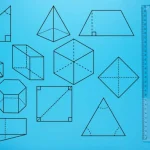
Non-congruent alternate interior angles & Alternate

Murder vs Manslaughter vs Homicide | Differences & Comparative Analysis

Intrafamily Transfer & Dissolution | Benefits & Example
Philosophy of discipline | classroom discipline & it’s types, mary anne bell in the things they carried | analysis & quotes.

27 Species Of Diving Ducks In Michigan
Restraining order vs protective order | definition, differences & types.

Receivable Management | Objectives, Importance, Strategies & Scope

Eye Of Horus vs Eye Of Ra | Background, Similarities & Differences
- How it works
- Top Writers
- TOP Writers
How to Write a Strong Creative Essay
An essay is a special type of written assignment that requires much more from the student than good research skills. The biggest component of successful essay writing is writing skills, and most people aren’t born with a set of skills that a professionally written essay requires. We acquire writing skills throughout our education, but what if you have an essay due in a couple of days and fear that your might lack creative writing skills?
This isn’t an uncommon situation at all – many students and newbie writers realize that putting their thoughts into words that will engage the audience and make up an interesting piece of writing isn’t the easiest thing in the world. However, there is also no need to become desperate, as we have some helpful tips to make your creative writing assignment easier and more successful.

What Is A Creative Essay?
So what exactly makes creative writing so different from anything else you’ll encounter in your life as a student and more challenging than any other assignment? A creative essay is a type of nonfiction writing, which means it should be based on real-life events. Unlike technical literature or journalistic pieces, creative essay doesn’t simply inform readers of an event or concept – it introduces the subject in a way that is fascinating and informative to the audience.
A creative essay writer can use different methods to convey their point of view: in many successful creative essays you will find as many literary devices as in a strong fiction piece. Depending on the purpose and the subject of the assignment, you may be asked to write a descriptive or narrative essay .
4 Features Of Creative Essay
There are several types of creative essays you may sooner or later encounter, but all truly creative nonfiction essays have these 4 features in common:
- The writer should base their writing on thorough research and analysis of the facts, which should then be interpreted for the story.
- A good creative essay combines facts with fiction in a manner that is both enlightening and entertaining to the readers.
- The writer employs various techniques to engage the audience starting from the very first sentence of the essay and keeps them interested until the last word.
- A creative essay needs to be based on a major, universal experience.
This is essentially everything you need to know about creative essay as a genre. If you want to know how to write a convincing creative essay, keep reading for some helpful tips!
How To Pick The Right College Creative Essay Topic
If you are free to choose your own topic for the next creative essay assignment, here are some ways to find the perfect topic for your writing exercise:
- Find a concept that greatly influenced your opinion and tell your audience about it;
- Imagine you have been assigned as a keynote speaker: what would you talk about?
- Describe your biggest talent and how it helped you navigate through life;
- Choose one historical event from the past that influenced you the most and talk about it;
- Who is the one historical figure you would like to talk to and why?
- Choose a viral video or some other piece of content everyone is familiar with and analyze it.

How To Write A Creative Essay
Working on any writing assignment and creative essay in particular requires a lot of effort from you, and in order to do the best job with creating a convincing piece of writing, there are some rules you need to follow. As soon as you have the topic for your essay, it is time to brainstorm some ideas. The best way to keep the ideas organized and connected to each other is to create a mind map, which will highlight the links between different concepts and points of your writing.
The next thing you need to do is conduct thorough research using every method available to you to gather as much evidence supporting your ideas as possible. You can use internet for doing the research, but don’t forget to properly reference your findings in the writing. When enough research was done, you can move on to creating the outline of your work. And don’t forget to design a powerful thesis , as it will serve as the base for the rest of the essay.
Creative Essay Structure
The structure of a typical creative essay isn’t different from the most traditional written assignment structure you likely worked with before. Your creative essay needs to have an introduction, at least three body paragraphs, and conclusion.
The introduction has to be powerful: view it as a way to grab attention of your readers and convince them to give your piece a more detailed look. The first sentence is especially important in this regard: you can use statistics, facts, quotes, or anecdotes as your hook. The final sentence of your introduction is a thesis statement – make sure to put some extra thought into it.
The next step in writing a creative essay is designing the body paragraphs. Each key point of your essay needs to be discussed in a separate paragraph. Start each paragraph with an opening sentence that explains what the readers are about to find out from the paragraph. Each point must be supported by strong evidence. You should also use smooth transitions between each paragraph to ensure a logical flow of the writing and showcase your excellent writing skills.
The conclusion is the finishing touch that also influences the success of your essay. Here you can once again state your thesis, briefly reintroduce the supporting ideas, and tell the audience why your work is significant.
Editing and Proofreading
Even the most skilled writers create several drafts of their work before showing it to the audience. Editing your essay may take some time, but it’s the best way to make sure your writing meets the highest standards. When reading and editing your work, pay attention even to the smallest details: correct the structure and flow of the essay if necessary.
Proofreading is another important aspect of essay writing. While proofreading your essay, you not only have to correct possible grammar and punctuation mistakes, but also ensure that your choice of words fits proper academic style. Of course, spelling mistakes have no place in a quality creative paper.
Writing a Creative Essay Title
The title of your creative essay is the first impression the reader gets of your work, so it’s super important not to take time and pay enough attention to coming up with a great title for the essay .
The title should be completely relevant to the subject and grab the reader’s attention from the first words. The most effective strategy for designing a winning title is taking the most essential idea of the essay and rewriting it to make it even more powerful and engaging.
Do You Need Help with Creative Essay?
These tips explain the nature of writing creative essay and give you some valuable insight into how to do a great job in this challenging task. But what if writing is simply not your forte? What if you have been looking for the ideal essay topic for days but still haven’t found one? What if there is simply not enough time and you already have several other important assignments?
Many students struggle with writing creative essays, but there is one simple solution that will help you improve your grades in the most effortless way possible! Let our professional writers create the essay for you, strictly following all the guidelines and requirements you provide. We have every tool and solution to deliver custom-written academic papers whenever you want, so don’t hesitate and get in touch with us to get the help you need .

- Essay Guides
- Basics of Essay Writing
How to Write a Creative Essay: Super Creative Guide for A+ Result
- Speech Topics
- Essay Topics
- Other Essays
- Main Academic Essays
- Research Paper Topics
- Basics of Research Paper Writing
- Miscellaneous
- Chicago/ Turabian
- Data & Statistics
- Methodology
- Admission Writing Tips
- Admission Advice
- Other Guides
- Student Life
- Studying Tips
- Understanding Plagiarism
- Academic Writing Tips
- Basics of Dissertation & Thesis Writing
- Research Paper Guides
- Formatting Guides
- Basics of Research Process
- Admission Guides
- Dissertation & Thesis Guides

Table of contents
Use our free Readability checker
A creative essay is a type of writing where students express their imagination and artistic style. It involves creative storytelling techniques, not just stating mere facts. The aim is to engage the reader, often exploring emotions, personal experiences, or fictional narratives. Creative writing can be found in various types of papers, including narrative essays or descriptive essays.
Continue readng our guide to learn how to write a creative essay like a professional writer.
What Is a Creative Essay
As we said before, the creative essay should deal with forcing students to think creatively and broader. Creative nonfiction essays are about creating a story and telling it most interestingly and entertainingly. The ending should be unexpected. The plot should be interesting and engaging. And if you want to do creative writing essays, you love the fact that there are no restrictions on the topic. All you need to do is to be creative in your own way and style to stand out.
General Tips on How to Write a Creative Essay
How to write a creative essay if you used to those tight restrictions and borders of standard prompts? It is easier than it seems. You should keep in mind that this task is the most liberated from all you can be ever assigned with in college. Here are some steps you should consider if there is a desire to learn how to write creative writing essays.
- Start with the topic Before any other step in your writing process, you need to come up with the main idea. You are free to write about anything you want.
- Research If you have decided to write about something that is close to your heart, you need to get as many details as you can. You can be totally into the topic, but there always is something more to find out.
- Make a plan Think of the questions which your topic can answer on. Try to set your story to make it engaging and informative from the start.
- Note all ideas Start taking notes about your story and even creative essay titles from the very beginning. Not even a half of those ideas will take place in your essay, but it is better if you have a selection to choose from.
- Create a raw draft This part will give you an opportunity to try out different styles and methods of writing . The more diversity of both you have in your essay, the better it is. Work with your raw draft, make it logical, and after that, begin creating the final version.
Your final step is to make revision . It is the last and crucial part of every essay writing.
Creative College Essay Topics and Ideas
Let’s talk more directly about the creative college essay topics. You can’t start working before you choose your topic. It should be interesting both to you and your audience. It is the only way to succeed in all directions. Here are few suggestions to your creative nonfiction essays you can use a starting mark:
- Describe an exciting event that turned your world upside-down.
- Think of tendencies that can cause the end of the world.
- Get a love story covered with some absolutely unrelated event.
- Tell a story of a man who has succeeded fighting for human rights.
- Describe a society controlled by Artificial Intelligence .
- Tell about your favorite things and those aspects you can’t imagine your life without.
- What would you do if you became absolutely invisible for some period of time?
- What would you do if you could live in somebody else’s body?
As you see, the diversity of creative nonfiction essays topics can be absolutely huge. There are no limits, and you should get a positive effect out of it. should you experience any difficulties with topic selection or writing process, contact our essay writers for expert assistance. StudyCrumb is always there for you to provide magnificent results.
How to Write Creative Essay Titles
Creating a title for your creative nonfiction essays is not the next stage after coming out with the topic idea. You can get a title at any stage of your writing creative essay titles and preparing process. Here are some tips for your creative essay title generator to improve:
- It should be catchy – it may seem obvious, but it is a big deal. Not all students are aware how to create catchy titles and even how important it is. But you need to use every aspect of your article to catch reader’s attention.
- Try to summarize the entire story you have in just three words. Include those three striking and descriptive words and expand with a short phrase.
- You may use a quote that describes or relates to the topic of your essay. It is not important who said those words, but its power and catchiness.
- The main idea can become your title as well. But note that it should be still interesting to your readers.
Creative Writing Essays Tips to Polish Your Paper
You need to understand that breaks are very important in your working process. It is necessary to get a perfect balance between resting and writing. Your mental effectiveness is limited to some mark, and you should not cross that line too often. It is dangerous enough to do that as you are risking getting exhausted and bored. Then after finishing your essay do these three things to make it complete and polished.
- Read your essay aloud for few times This trick works great to check the tempo and structure of an essay . It should sound and read with the same tempo and flow through the entire article with no too obvious picks and delays. You just need to realize how it sounds to other people and how the entire flow goes.
- Check the grammar and other problematic moments Grammar is essential to your paper’s success. No one needs a great story that is written with lots of mistakes that completely break the whole flow. Use a free grammar checker by StudyCrumb, thesaurus or default checker on your computer. Try to bring more descriptive moments to the game to make your essay shine and be diverse. Ask anyone who is into grammar great to check your paper too.
Creative Nonfiction Essays Tip from Our Experts
Most students love writing creative essays. But some of us got so used to all those restrictions and limits that come to creativity, we just can’t think outside of the box. Our writing experts recommend trying a special technique called “jam write.” It works perfectly to get rid of writer's block and expand your imagination. Just sit down and describe your topic with non-stop writing for at least five minutes. You may also ask our experts to help you out. Just place your order to get a professional help anytime you need.

Daniel Howard is an Essay Writing guru. He helps students create essays that will strike a chord with the readers.
You may also like

Essays About Creativity: Top 5 Examples and 7 Prompts
Creativity helps us understand and solve problems in different ways. Discover our top essays about creativity examples and use our prompts for your writing.
Albert Einstein defines creativity as “seeing what others see and thinking what others have not thought.” But what makes it such a popular topic to write about? Every person has a creative view and opinion on something, but not everyone knows how to express it. Writing utilizes ideas and imagination to produce written pieces, such as essays.
Creativity reinforces not only new views but also innovation around the world. Because creativity is a broad topic to write about, you’ll need several resources to help you narrow down what you want to discuss in your essay.
5 Essay Examples
1. way to foster creativity in young children by anonymous on ivypanda.com, 2. phenomenon of creativity and success by anonymous on ivypanda.com, 3. do schools kill creativity: essay on traditional education by anonymous on gradesfixer.com, 4. creativity in dreams essay by writer pete, 5. the importance of creativity in higher education by anonymous on gradesfixer.com, 1. what is creativity, 2. how creativity affects our daily lives, 3. the impact of creativity on students, 4. the importance of creativity, 5. creativity: a product of perception, 6. types of creativity, 7. art and creativity.
“There are different ways to foster creativity in young children. They include different approaches to the problem of making children more self-reliant, more creative, and more interested in the process of receiving education, obtaining experience, achieving certain results in the sphere of self-study.”
The essay delves into the importance of promoting creativity by teaching music to young students. The author says music’s intention, rhythm, and organizational features help people understand performance, improve their mood, and educate them about the world they live in, unlike noise. Music is an important area of life, so it is important to teach it correctly and inspire children.
Since music and creativity are both vital, the author notes that music teachers must find ways to facilitate ventures to enhance their students’ creativity. The author also believes that teachers must perform their duties appropriately and focus on shaping their students’ behavior, personality, and worldview. You might be interested in these articles about art .
“Over the past few decades, creativity has evolved from a characteristic normally associated with artistic activities into a quality that is found in people of various professions. However, in the 21st century, creativity has become a rather controversial issue.”
The author discusses that while creativity dramatically contributes to the success of individuals and companies, creativity in the 21st-century workplace still has mixed reception. They mention that creativity leads to new ideas and innovations, helps solve complex problems, and makes great leaders.
However, some still see creative people as irrational, disorganized, and distracting in the workplace. This often results in companies rejecting applicants with this quality. Ultimately, the writer believes creativity is vital in all organizations today. Hiring people with this unique trait is highly beneficial and essential to achieving the company’s goals. For more inspiration, check out these essays about achievement and essays about curiosity .
“… the traditional education system has caused much controversy since the beginning of formal education because traditional education can hurt children’s ability to think creatively, innovate, and develop fascinating minds.”
The essay discusses how school rules and norms affect students’ expression of true individuality. The author mentions that today’s schools focus on students’ test performance, memorization, and compliance more than their aspirations and talents, preventing students from practicing and enhancing their creativity.
The author uses various articles, shows, and situations to elaborate on how schools kill a student’s creativity by forcing them to follow a specific curriculum as a means to succeed in life. It kills the student’s creativity as they become “robots” with the same beliefs, knowledge, and values. According to the writer, killing a child’s creativity leads to a lack of motivation and a wrong career direction.
“Creativity is enhanced whether one chooses to pay attention to it, or not. Each person has the capacity to learn much from their creative dreaming, if they would only think more creatively and openly when awake.”
The essay contains various studies to support claims about people being more creative when asleep. According to the author, the human brain processes more information when dreaming than in the waking state. While the brainstem is inactive, it responds to PGO Waves that trigger the human CMPG, which puts images into the dream to move. The author discusses two main perspectives to discuss how creative dreaming occurs.
First, creativity is enhanced when a person sleeps, not through dreaming but because the mind is free from stress, making the brain more focused on thinking and creating images. The second is that the dreaming mind gathers and processes more information than the human brain unconsciously accumulates daily. The author states that creativity helps express feelings and believes people should not take their creativity in dreams for granted.
“When students have the opportunity to be creative, they’ll have the freedom to express themselves however they want, which satisfies them and drives them to work hard.”
The essay focuses on how the role of creativity is getting slimmer as a student enters higher education. To explain the importance of creativity, the author shares their experience showing how elementary schools focus more on improving and training students’ creativity than higher education. Although rules and restrictions are essential in higher education, students should still practice creativity because it enhances their ability to think and quickly adapt to different situations.
If you want to use the latest grammar software, read our guide to using an AI grammar checker .
7 Prompts for Essays About Creativity
Creativity is an important topic that significantly affects an individual’s development. For this prompt, discuss the meaning of creativity according to experts versus the personal interpretation of creative individuals. Compare these explanations and add your opinion on these similarities and differences. You can even discuss creativity in your life and how you practice creativity in your hobbies, interests, and education.
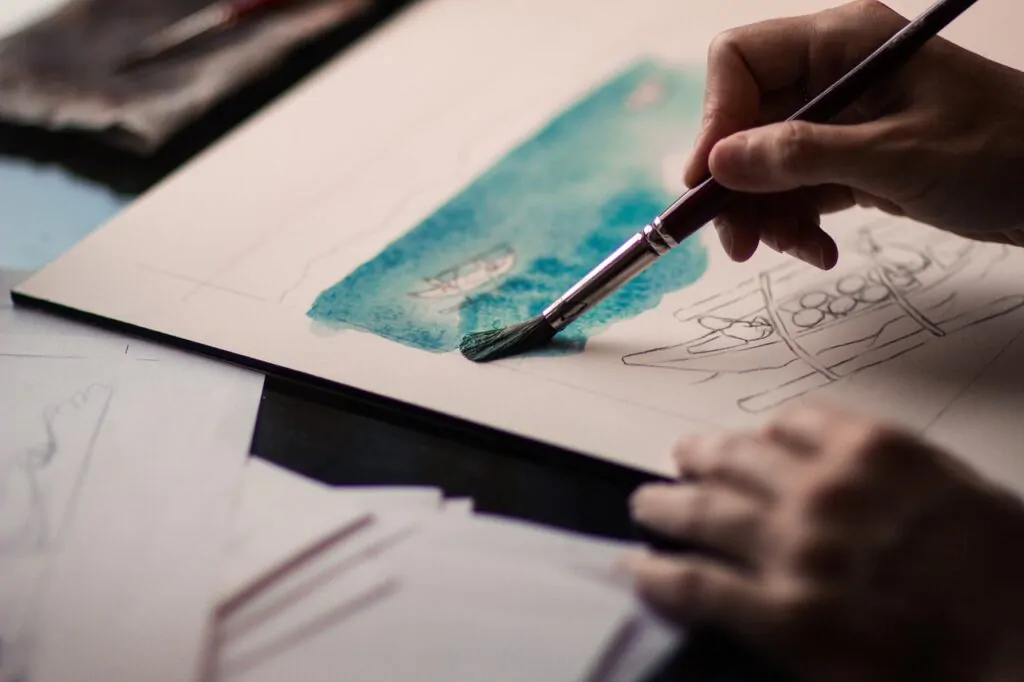
There are several impacts of creativity in one’s life. It improves mental health, strengthens the immune system, and affects one’s ability to solve problems in school and real life. Sometimes, being creative helps us be more open to various perspectives to reduce our biases.
Use this prompt to write about a specific situation you experienced where creativity made you more innovative, inventive, or imaginative. Discuss these particular moments by pointing out creativity’s impact on your goal and how things would differ without creativity. You may also be interested in learning about the different types of creativity .
Creativity significantly impacts students’ enthusiasm and feeling of belongingness as they share their passion. Additionally, creativity’s effects stretch to students’ career choices and mental health.
Use this prompt to start a discussion of the pros and cons of creativity with students. Give examples where a student’s creativity leads to their success or failure. You can also share your observations as a guardian or a student.
Sometimes, when we lose touch with our creative side, our viewpoint becomes shallow. Creativity not only works for art but also broadens everyone’s perspectives in life.
For this prompt, speak about how creativity matters and prove its importance by providing a situation. Theorize or discuss how creative people and people who fail to increase their creativity respond to the case.
Perception is an underlying characteristic of creativity. It interprets what we observe, while creativity allows us to make sense of them. Use this prompt to define perception to the readers through the lens of creativity.
List your experience proving creativity is a product of perception. For example, people can have vastly different interpretations of a painting or sound depending on how they perceive it.
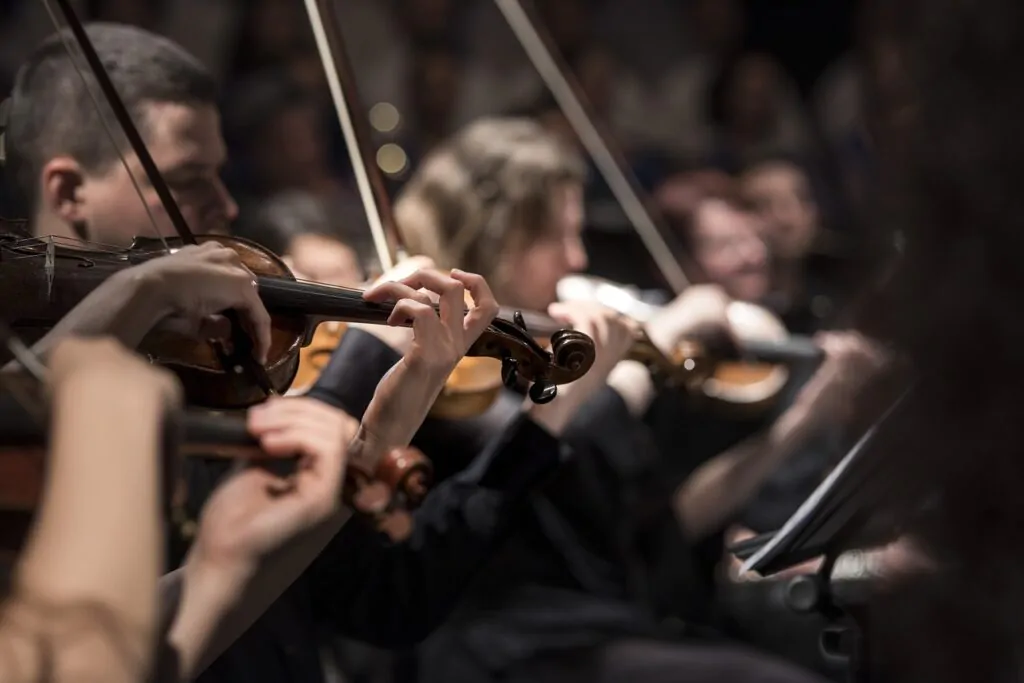
There are several types of creativity, some people believe creativity is a natural talent, but others say it can be cultivated. In this prompt, briefly define creativity and identify each type, such as musical, artistic, or logical.
Discuss how creativity can be taught and cultivated, and look into how some people are naturally creative. In your essay, use real-life examples; this could be someone you know who has studied a creative subject or a friend who is a naturally creative songwriter.
When people say creativity, they usually think about art because it involves imaginative and expressive actions. Art strongly indicates a person’s ongoing effort and emotional power.
To write this essay effectively, show how art relates to a person’s creativity. Briefly explain creativity and art and incorporate the factors that link these two. Note that art can be anything from contemporary dance and music to sculptures and paintings. For help with your essay, check our round-up of best essay writing apps .

Maria Caballero is a freelance writer who has been writing since high school. She believes that to be a writer doesn't only refer to excellent syntax and semantics but also knowing how to weave words together to communicate to any reader effectively.
View all posts
- Bipolar Disorder
- Therapy Center
- When To See a Therapist
- Types of Therapy
- Best Online Therapy
- Best Couples Therapy
- Best Family Therapy
- Managing Stress
- Sleep and Dreaming
- Understanding Emotions
- Self-Improvement
- Healthy Relationships
- Student Resources
- Personality Types
- Guided Meditations
- Verywell Mind Insights
- 2023 Verywell Mind 25
- Mental Health in the Classroom
- Editorial Process
- Meet Our Review Board
- Crisis Support
How to Boost Creativity
Kendra Cherry, MS, is a psychosocial rehabilitation specialist, psychology educator, and author of the "Everything Psychology Book."
:max_bytes(150000):strip_icc():format(webp)/IMG_9791-89504ab694d54b66bbd72cb84ffb860e.jpg)
Amy Morin, LCSW, is a psychotherapist and international bestselling author. Her books, including "13 Things Mentally Strong People Don't Do," have been translated into more than 40 languages. Her TEDx talk, "The Secret of Becoming Mentally Strong," is one of the most viewed talks of all time.
:max_bytes(150000):strip_icc():format(webp)/VW-MIND-Amy-2b338105f1ee493f94d7e333e410fa76.jpg)
Creativity is the ability to come up with or recognize ideas to solve problems, communicate with others, or entertain.
Creativity is all about finding new ways of solving problems and approaching situations. This isn't a skill restricted to artists, musicians, writers, or "right-brained" thinkers; it is a useful skill for people from all walks of life . If you've ever wanted to boost your creativity , these tips can help.
Commit Yourself to Creativity
The first step to increasing creativity is to devote yourself to developing your creative abilities. Do not put off your efforts. Set goals, enlist the help of others, and put aside time each day to develop your skills. For example, if you are interested in painting, schedule time regularly to learn and practice your skills.
Boost Creativity by Becoming an Expert
One of the best ways to develop creativity is to become an expert in this area. By having a rich understanding of the topic, you will be better able to think of novel or innovative solutions to problems. One way to develop expertise is by reading about creative people and listening to them speak.
Reward Your Curiosity
One common roadblock to developing creativity is the sense that curiosity is an indulgence. Rather than reprimanding yourself for following an internet rabbit hole, reward yourself when you are curious about something. Give yourself the opportunity and the time to explore new topics.
Rewarding yourself is important, but developing intrinsic motivation is also crucial. Sometimes, the true reward of creativity is the process itself, not the product.
Take Risks to Build Creativity
When it comes to building your creative skills, you must be willing to take risks to advance your abilities. Although your efforts may not lead to success every time, you will still be boosting your creative talents and building skills that will serve you well in the future.
For example, sharing your work in a creative writing course might feel intimidating. But the critique you receive from classmates and teachers can be invaluable.
Build Your Confidence
Insecurity in your abilities can suppress creativity, which is why it is important to build confidence. Note your progress, commend your efforts, and always be on the lookout for ways to reward your creativity.
Make Time for Creativity
You won't be able to develop your creative talents if you don't make time for them. Schedule some time each week to concentrate on some type of creative project.
Making time for creativity might involve saying no to some things that are draining your available time, or even choosing to let go of things in your schedule that are not bringing you joy. Sometimes, it might even involve asking others to help with tasks or take care of childcare and other household duties so you have some free time for your creative pursuits.
Overcome a Negative Attitude
Focus on eliminating negative thoughts or self-criticisms that may impair your ability to develop strong creative skills. Recognize these as roadblocks and work to overcome them.
When you find yourself dwelling on negative thinking, make an active effort to challenge those faulty ideas and replace them with more realistic or positive ones.
Fight Fear of Failure
The fear that you might make a mistake or fail in your efforts can paralyze progress. Whenever you find yourself harboring such feelings, remind yourself that mistakes are simply part of the process. While you may occasionally stumble on your path to creativity, you will eventually reach your goals.
Brainstorm New Ideas
Brainstorming is a common technique in both academic and professional settings, but it can also be a powerful tool for increasing creativity.
Start by suspending your judgment and self-criticism. Then start writing down related ideas and possible solutions. The goal is to generate as many ideas as possible in a relatively short span of time. Next, focus on clarifying and refining your ideas in order to arrive at the best possible choice.
As unlikely as this may seem, recent research points to dim light as a trigger for creativity. Darkness may free you from perceived constraints and encourage you to take creative risks that may seem intimidating in bright lighting.
Explore Multiple Solutions
The next time you approach a problem , try looking for a variety of solutions. Instead of simply going with the first idea you have, take the time to think of other possible ways to approach the situation. This simple activity is a great way to build both problem-solving and creative thinking skills.
Keep a Creativity Journal
Start keeping a journal to follow your creative process and track the ideas you produce. A journal is a great way to reflect back on what you have accomplished and look for other possible solutions. This journal can be used to save ideas that can later serve as future inspiration.
Use Mind Maps and Flow Charts
A mind map is a way to connect ideas and look for innovative answers to questions. Create a mind map by writing down a central topic or word. Next, link related terms or ideas around the central word. While similar to brainstorming, this technique allows for branching ideas and offers a very visual way of seeing how ideas are linked.
As you start to develop a new project, create a flow chart to track the project from start to finish. Look for various paths or sequences of events that might occur. A flow chart can help you visualize the final product, eliminate potential problems, and create unique solutions.
Challenge Yourself and Create Opportunities
Once you have developed some basic creative skills, it is important to continually challenge yourself to further advance your abilities. Look for more difficult approaches, try out new things, and avoid always returning to the same solutions you have used in the past.
In addition to challenging yourself, you also need to create your own opportunities for creativity. This might involve tackling a new project or finding new tools to use in your current projects.
Try the Six Hats Technique
The "six hats" technique involves looking at a problem from six differing perspectives. By doing this, you can produce more ideas than you might have had you only looked at the situation from one or two points of view.
- Black hat : Use a negative perspective. Which elements of the solution won’t work?
- Blue hat : Think broadly. What is the best overall solution?
- Green hat : Think creatively. What are some alternative ideas?
- Red hat : Look at the situation emotionally. What do your feelings tell you?
- White hat : Look at the situation objectively. What are the facts?
- Yellow hat : Use a positive perspective. Which elements of the solution will work?
Find Inspiration to Boost Creativity
Never expect creativity to just happen. Look for new sources of inspiration that will give you fresh ideas and motivate you to generate unique answers to questions. Read a book, visit a museum, listen to your favorite music or engage in a lively debate with a friend.
Use whatever strategy or technique works best for you. Do you enjoy video games? Research indicates that playing video games can help increase your creativity.
Consider Alternative Scenarios
When approaching a problem, ask "what if..." questions to consider each possible scenario. If you take a specific approach, what will the outcome be?
By looking at these alternatives beforehand, you'll be better able to develop creative solutions to problems.
Try the Snowball Technique
Have you ever noticed how one great idea often leads directly to another? You can take advantage of this by using a "snowball technique" when you are generating ideas for a project. If an idea isn't appropriate for your current work, set it aside to work on later, or implement it in a future project.
Frequently Asked Questions
Strategies that can help stimulate creative thinking include challenging yourself to think about things differently, engaging in leisure activities that reduce stress, having social interactions with other people, and taking a break from a task to go for a walk.
Give yourself time to be creative. Engage in hobbies and pursue the things that spark your interests. Allow yourself to daydream or imagine different scenarios. Perhaps most important, allow yourself the freedom to pursue different ideas and take risks. Not every idea will pan out, but the process and practice will help you boost creativity and develop a stronger imagination.
Franken RE. Human Motivation . 3rd ed. Brooks/Cole Publishing Company.
Steidle A, Werth L. Freedom from constraints: Darkness and dim illumination promote creativity . J Environ Psychol . 2013;35:67-80. doi:10.1016/j.jenvp.2013.05.003
Tilly M. How to create a mind map (+examples) . The Institute of You.
De Bono E. Six Thinking Hats . Penguin, Limited.
Blanco-Herrera JA, Gentile DA, Rokkum JN. Video games can increase creativity, but with caveats . Creat Res J . 2019;31(2):119-131. doi:10.1080/10400419.2019.1594524
By Kendra Cherry, MSEd Kendra Cherry, MS, is a psychosocial rehabilitation specialist, psychology educator, and author of the "Everything Psychology Book."
How to Write a Creative Essay: Tips, Topics, and Techniques
What is a creative essay, if not the way to express yourself? Crafting such a paper is a task that allows you to communicate your opinion and tell a story. However, even using your imagination to a great extent doesn’t free you from following academic writing rules. Don’t even get us started about other components of papers. With tools like research paper title page generators available, it only proves to be a serious business.
Our specialists will write a custom essay specially for you!
Confused yet?
No need to be! Creativity can be worked into many different types of essays. You just have to know how to write a creative essay deftly, thus:
- paying attention to your reader;
- using an essay structure;
- incorporating details and metaphors;
- don’t be afraid to speak your mind!
Turn to our writers when in doubt or read the rest of the article for more recommendations.
🎨 Types of Creative Essays
🧩 creative essay format, 🖌️ how to write a creative essay, 📜 creative essay topics.
Where analysis ends, creativity begins!
You can include creative expression in an essay or paper you write. Yet, some pieces are designed specifically to allow you to be creative. You can choose a topic that will set your imagination free.
Just in 1 hour! We will write you a plagiarism-free paper in hardly more than 1 hour
Here are a few types of creative essays you can embrace:
- Narrative Essay :
The narrative essay is much like novel writing. This essay type can be used to discuss either real or imaginary events. The key in this type is that you have to show, not tell. For you to accomplish this, your essay will need a plot, many descriptive details, and well-written prose.
- Admission Essay :
The admission essay is becoming increasingly popular. When it is well-written, it allows you to stand out among thousands of students who are vying for admission to a particular program. The admission essay is a way for you to talk about yourself and why you would make a great addition to a program. Essentially, you are advertising yourself to show that you are the best choice.
- Personal Essay :
The personal essay is similar to the admission essay but less aggressive. This form of essay is used to talk about yourself and your experiences, trying to persuade the reader that a particular event or aspect of your personal life is significant in some way. Consider this form of creative writing essay a self-portrait that you paint with words.
- Descriptive Essay :
You can choose any topic you wish for the descriptive essay. The key is that the central idea should be of interest to or affect the reader. Once you select one, describe it throughout your essay, stating why it is crucial to you.
Receive a plagiarism-free paper tailored to your instructions. Cut 20% off your first order!
- Lyric Essay:
This is very much like the descriptive essay, except that it makes greater use of imagery and description.
- Americanism Essay :
The Americanism essay is popular with scholarship committees. This is the “why I am proud to be an American” essay.
- Reflection Essay:
The reflection essay offers you a way to provide feedback on an event or other topic with which you are not happy, or it bothers you in some way.
Victor Valley College and the University of Vermont offer some great advice on writing creative essays. Now let’s look at some techniques that will help you write creatively.
Creative essays usually follow the three-act story structure . It is a classic writing technique commonly used in storytelling, screenwriting, and drama. It divides a story into three parts: the setup , confrontation , and resolution . The three-act story structure allows for the effective development of characters and conflicts, which leads to more compelling writing.
Get an originally-written paper according to your instructions!
Check out the creative essay format below.
The stage is set in this initial part of the story where the main characters, setting, and central conflict are introduced. Readers are given a glimpse into the story’s world and get to know the characters and their motivations. The setup establishes the foundation for the narrative, laying out the groundwork for the conflicts that will unfold.
Confrontation
Confrontation is where the story’s central conflict develops and the tension rises. Obstacles and complications that arise during that stage are meant to test the characters, pushing them to their limits. The confrontation is filled with rising action as the characters face increasingly difficult challenges.
The story reaches its climax, and the conflicts are brought to a head. The tension built up in the previous stage comes to its peak as the characters confront their challenges head-on. The resolution provides closure to the story, ties up loose ends, and resolves the central conflict.
The Oxford Royale Academy offers useful creative writing tips that can easily be applied to creative nonfiction.
The key is:
Creative writing is not solely about putting words on a page in a way that presents imaginative prose. You need to consider your writing in a certain way and structure it properly if you want to pull off an excellent creative essay.
Here are some tips and techniques for any creative nonfiction writing you do:
- Consider the reader: As with any other form of writing, you must consider the reader above all else. You have to have a deep understanding of who your audience is so you can pique their interest and hold it throughout the paper.
- Start it off right: You need to start your paper off with a bang! That means you have to have an opening to your essay or paper that will grab the attention of whoever reads it. This could be a bold phrase, the description of something that happened, or some profound or persuasive words. Your opening needs to scream, “Keep reading!”
- Use the traditional creative structure: Traditionally, creative essays are divided into three acts: the setup, the confrontation, and the resolution. In the first one, you will introduce the leading players and the situation. The confrontation will allow you to shift into the main issue. The resolution is the climax, during which the issue is resolved.
- Use metaphors: A metaphor is effective in any form of writing. In a creative essay writing, use an analogy to help provide the reader with a clear image. It should make them understand a concept you are explaining at a deeper level.
- Provide details: Details are everything when writing creatively as they tug at the readers’ emotions. Without them, your essay can be stale and boring, providing only one fact. Detail spruces it up and makes it come alive in the readers’ minds.
- Edit, edit, edit: Make sure to edit your work after you have written it. A writer rarely gets it right the first time.
- Think out of the box: Finally, here it comes—the piece of advice that every successful assignment demands. Try to approach the issue from an unusual angle!
The Oxford Royale Academy also has some great information on general essay writing that is sure to help!
Now, let’s take a look at some creative writing topics you might be able to use.
The goal behind any writing assignment that calls for creativity is simple. You have to express your feelings and opinions on a particular topic so that it captivates the reader. These creative papers and essays are not dry and boring the way most of us imagine academic works.
But what should you write about? You need some creative essay ideas. Whether the topic is assigned or you choose it yourself, you’ll have to decide how to approach it. If you pick an issue yourself, the options might be overwhelming.
With that in mind:
Let’s start on a journey to find fun essay topics! You can:
- Choose something you are interested in by making a list of issues or problems that matter to you.
- Narrow down a broader issue.
- Find inspiration from materials and records to which you have access or from your coursework.
There are plenty of topics for narrative essays and other creative writing essays on the Internet. Here are some great ideas for nonfiction writing topics to get your imagination moving:
- Describing thoughts inspired by a picture.
- Are art and nature vital parts of human life?
- Creativity can change the world.
- What is pride?
- The desire to travel lives in every person.
- My visit to Rio de Janeiro .
- Is it a good idea to be a stay-at-home mother ?
- Various feelings about cheating .
- Is early marriage a good or a bad thing?
- The importance of the Era of Good Feelings for American history.
- What will your future be in five years ?
- Family fitness night is a great way to unite a family.
- Bachata as a music genre .
- How do you understand love ?
- The role of money issues in strong relationships.
- What person can be a true friend ?
- The definition of jealousy .
- Is creativity a panacea from depression?
- Emotional intelligence is crucial for healthy relationships.
- Postmodernist and experimental dance forms.
- How I trained my dog at home.
- Poetry as a way to express emotions .
- What makes a strong marriage ?
- Photography as a professional art and creative hobby.
- Problems in the neighborhood and how to deal them.
- Why do Carolina dogs make great pets?
- Feeling of joy and its value for people .
- How emotional intelligence can help me to become a great leader.
- The role of conservatism in preservation of traditional American culture.
- What can a freelancer do to stay creative ?
- A memorable event from my past.
- Peculiarities of friendship in the age of media .
- Interconnection between emotions and memories .
- Is consumerism a part of American culture?
- Different understanding of art .
- What can do to save lakes and oceans wildlife ?
- Examples of the emotion of sadness in art.
- The creative way to organize a workplace at home .
- Emotions that paintings stir in people.
- Why Dresden is a great place to travel.
- How to fight the feeling of powerlessness .
- Personal experience adopting a pet from Humane Society .
- Is it possible for computers to have independent feeling ?
That’s it! When it comes to creative writing, you can do it! For more help on writing essays, check out this video.
If you still feel the task is too much to handle, you can turn to a custom writing service. Share the article with those who may need our advice and happy writing!
- Essays: Creative Nonfiction
- Overview of Creative Nonfiction: Purdue Online Writing Lab, College of Liberal Arts, Purdue University
- A Complete Guide to Writing Creative Nonfiction: MasterClass
- Share to Facebook
- Share to Twitter
- Share to LinkedIn
- Share to email

A compare and contrast essay — what is it? In this type of paper, you compare two different things or ideas, highlighting what is similar between the two, and you also contrast them, highlighting what is different. The two things might be events, people, books, points of view, lifestyles, or...

What is an expository essay? This type of writing aims to inform the reader about the subject clearly, concisely, and objectively. The keyword here is “inform”. You are not trying to persuade your reader to think a certain way or let your own opinions and emotions cloud your work. Just stick to the...
![how am i creative essay Short Story Analysis: How to Write It Step by Step [New]](https://custom-writing.org/blog/wp-content/uploads/2020/12/man-sits-end-trolltunga-before-mountains-284x153.jpg)
Have you ever tried to write a story analysis but ended up being completely confused and lost? Well, the task might be challenging if you don’t know the essential rules for literary analysis creation. But don’t get frustrated! We know how to write a short story analysis, and we are...

Have you ever tried to get somebody round to your way of thinking? Then you should know how daunting the task is. Still, if your persuasion is successful, the result is emotionally rewarding. A persuasive essay is a type of writing that uses facts and logic to argument and substantiate...
![how am i creative essay Common Essay Mistakes—Writing Errors to Avoid [Updated]](https://custom-writing.org/blog/wp-content/uploads/2020/12/avoid-mistakes-ccw-284x153.jpg)
One of the most critical skills that students gain during their college years is assignment writing. Composing impressive essays and research papers can be quite challenging, especially for ESL students. Nonetheless, before learning the art of academic writing, you may make numerous common essay mistakes. Such involuntary errors appear in:...

You’re probably thinking: I’m no Mahatma Gandhi or Steve Jobs—what could I possibly write in my memoir? I don’t even know how to start an autobiography, let alone write the whole thing. But don’t worry: essay writing can be easy, and this autobiography example for students is here to show...
![how am i creative essay Why I Want to Be a Teacher Essay: Writing Guide [2024]](https://custom-writing.org/blog/wp-content/uploads/2020/12/senior-male-professor-writing-blackboard-with-chalk3-284x153.jpg)
Some people know which profession to choose from childhood, while others decide much later in life. However, and whenever you come to it, you may have to elaborate on it in your personal statement or cover letter. This is widely known as “Why I Want to Be a Teacher” essay.
![how am i creative essay Friendship Essay: Writing Guide & Topics on Friendship [New]](https://custom-writing.org/blog/wp-content/uploads/2020/12/smiley-female-friends-fist-bumping-284x153.jpg)
Assigned with an essay about friendship? Congrats! It’s one of the best tasks you could get. Digging through your memories and finding strong arguments for this paper can be an enjoyable experience. I bet you will cope with this task effortlessly as we can help you with the assignment. Just...

When you are assigned an autobiography to write, tens, and even hundreds of questions start buzzing in your head. How to write autobiography essay parts? What to include? How to make your autobiography writing flow? Don’t worry about all this and use the following three simple principles and 15 creative...

“Where is your thesis statement?” asks your teacher in a dramatic tone. “Where is my what?” you want to reply, but instead, you quickly point your finger at a random sentence in your paper, saying, “Here it is…” To avoid this sad situation (which is usually followed by a bad...

A life experience essay combines the elements of narration, description, and self-reflection. Such a paper has to focus on a single event that had a significant impact on a person’s worldview and values. Writing an essay about life experience prompts students to do the following: evaluate their behavior in specific...

Who has made a significant impact in your life and why? Essay on the topic might be challenging to write. One is usually asked to write such a text as a college admission essay. A topic for this paper can be of your choice or pre-established by the institution. Either...
it was fascinating….but still you need to add more..tackle more on the format of a creative essay

Thank you for your detailed comment. Our team will take it into account.
I apprepriate this article and video. That’s worthy for all teachers and learners. This article and video are very useful and effective for all learners and teachers who wants to start creative writing .
Thank you! We really appreciate your opinion!
Many, many creative writing topics! Thanks so much for giving yourself the trouble to share these topics! They are a real salvation for me!
.png)
How to Write a Creative Essay in no Time: Topics & Example

Suffering from writer's block? Avoid panicking or thinking you are not talented enough to create something unique promptly since EssayService is here to give you custom essay help . Believe it or not, a lot of us have engaged in creative essay writing in one way or another at some point in our lives. In this article, we will define what is creative essay, while also exploring fun, interactive ways that one may use to surpass the difficulties of picking up good creative paper topics. Alternatively, you can always buy essay samples directly on our website in case you need good creative essay examples.
What is a Creative Essay
Regarding trying to explain how to write a creative essay, it is best to define it to help us break down the concept. Such assignments will require the student to create an intriguing fictional scenario, which may be based on real events, designed to fit given criteria. Thus, simply put, one may say the secret to finding good creative essay titles can be found by letting our imagination run wild. As strange as it may seem at first to engage in such activities since academic papers are usually quite objective and factual, seeking to communicate concrete ideas or solid arguments clearly and concisely. However, as different and unrelated as the two may seem. First, it is important to realize that what they both have in common is a unique set of creative essay writing techniques capable of making the task much easier. Both factual and creative essays are meant to be read by experts in the field and the general population. Thus it is crucial to maintain their interest in the piece.
One thing to admire about the art of writing a creative essay is that it has survived the test of time as it has endured various schools of thought critiquing its existence. Thus, what experts from our writing paper service will be exploring in the article are the elements that have secured its survival and how you should apply them in college. Using these items accordingly will give you the best possible sources of inspiration. Now that we have a basic understanding of what this assignment requires, it is time to look at what kind of creative writing topics produce the best results.

Popular Topics and Creative Paper Ideas
In case you have not been given any creative college essay prompts or have been looking for a starting point, here are some general ideas that could help guide you in the right direction.

- What if dinosaurs came back to life? What would we do as a response?
- Walk us through what it felt like to fall in love for the first time . A more romantic approach to any creative college essay assignment.
- Describe how you see the end of the world or explain why you think it is eternal?
- Explore religious themes like the existence of God or Heaven and Hell. What makes you know these things are a certainty?
- Create a scenario where a meteorite hit the earth , who knows what mysteries can be found near its remains.
- Do you like detective stories? Maybe you should give it a try in a creative essay!
- If World War 3 was to break out today whose side would you take and why? Is such a thing even reasonable after we have seen the result of two world wars already?
- Let us say you just got back home, but everything has changed on the inside from the furniture to the bathroom. Looking through the house, you realize nobody is home. Nonetheless, your keys opened the door. What will happen next in our creative college essay?
- What defines good and evil for us? More so who decides such a fact? Why is there such a controversy behind it?
- Your body has been frozen for 100 years , but now the slumber has ended. What does the future look like 100 years from now? Would you try to find your family or explore the future thinking they are all gone?
- If prose is not working out, why not try put your thought into rhymes? Poetry is a prevalent form of creative essay writing.
We hope these general ideas help shed some light on how one should begin exploring their creative essay writing ideas and turn them into fascinating topics for us all to enjoy reading. In the following sections, we will cover some effective tactics to use when tackling the assignment.

How To Combine the Art of Essay Writing and Storytelling?
We all have our unique gifts, however, if we find ourselves having writer's block or not knowing how to combine academic paper writing with the art of storytelling effectively then here's how it's done.

- Explain to yourself the main idea of the creative college essay and the main character, whether the antagonist or protagonist. Does it all make sense and flow smoothly?
- All academic assignments and creative essay topics must have an introduction and conclusion, they might be named or expressed differently, but the core idea does not change.
- Character development and the conflicts between them serve as the main body of the piece and thus should have the same impact on the audience.
- The creative essay topics use supporting characters the same way we use supporting arguments to help highlight a particular concept.
- Make sure to connect all the creative paper ideas and components as you would the statistics in a business plan to show any existing correlations between the data in the discussion.
- Another way to think about it is like a cause-and-effect essay that gets a little more imaginative than usual, filled with mythical characters and magical adventures.
Finding any means to make the assignment more relatable to oneself is the key to breaking it down into reachable goals. Nonetheless, keep in mind that it is vital to maintain the reader's interest throughout the paper. We hope some of these suggestions come in handy when tackling your creative college essay.
How To Tackle the Creative College Essay?

- Identify your audience from the start.
Before one begins to set the tone in their creative college essay, it is vital to identify our audience as this helps narrow down the style that the piece should follow. Let us pause briefly and give it some consideration. To perform beyond expectation, we must find the means to keep the readers hooked and leave them wanting more. Thus, let us look at who our audience might be while putting our wits to the test with creative paper ideas.
In most cases, the audience will be our college/university lecturers or high school teachers, so there is not much to worry about. It is not an unknown fact that these professors often have to grade many creative writing essays, meaning they have a pretty good idea of what the result should look like. If they have set the prompts themselves, then even more so, they are anticipating a particular type of response. However, this is a chance to make your creative essay stand out from the rest. Keep in mind there is a very high possibility they might be slightly bored when they read your piece. Hence it is vital to capitalize on the opportunity. You know what they say, beat the iron while it's hot!
Lastly, a rather forgotten fact is the lecturers grading all these creative college essays are on a tight schedule, as grades need to be submitted by a particular date. With that in mind, professionals from different writing services like our write my essay service recommend revisiting your piece as often as possible before submitting it. That's because the examiners will likely not have the time or energy to go over poorly written passages and try to make sense of them all. One of the best ways to avoid this during the editing stage is by structuring the creative college essay sentences in a concise fashion that is easy to read and gets to the point without any hesitation.
- Brainstorm potential creative essay topics or use the given prompts
Having a readily given prompt can be a great help in such a situation as one may develop their creative essay plot around it. Nonetheless, if you have to start writing from scratch, think of something that will most likely not be overused by everyone. It is often considered a good idea to bounce ideas off your classmates as it will help create something unique. If that does not give the desired result, try going into a quiet room and jotting down every creative idea you have. It might not sound like much, but it will generate a starting point that can later be defined and edited. Remember, these are just drafts.
- Always record your thoughts
As previously mentioned, having a lot of variety is good in creative essay writing since it allows you to explore various possibilities for the story and its plot. Thus, even when having what seems to be an uninspired thought, write it down; it could come in handy later. Some of our greatest ideas often come at random moments, so be prepared when tackling such an assignment.
- Grab the reader's attention using witty metaphors as well as interesting settings or locations
This is where things get tricky in our creative college essay assignment. It is not a mystery that we all like different things; it's why we can enjoy so many flavors of Ben n Jerry's ice cream. The same spectrum of variety should be included in our use of metaphors, allegories, and other literary elements to spice up our creative college essay. Some of the best places to take advantage of these are considered; for example, when trying to explain a rather complex meaning or comparison, one may use an analogy to convey the meaning better. Doing so helps the reader visualize the concept being explained, leading to the experience becoming more relatable and a tendency to become personally involved in the piece. In their creative college essays, some writers describe one of their characters as similar to a flowing river. When doing this, we can illustrate how obstacles throughout their journey might impede them, but just like the river, they will find a way to course right through it in time.
Effectively using these elements is just a part of hooking the reader. The next step is bringing the creative essay to life using fascinating settings and exotic locations bound to keep the audience interested. It is similar to seasoning a meal; it just doesn't taste the same without the perfect amount of added ingredients.
How To Structure A Creative Essay
College papers can have many structures, formats, and referencing styles in today's academic environment. However, if you have not been given a particular form to run with by the lecturer, then it is strongly advised to get acquainted with the three-act structure. What it does for our creative college essay is give it a basic skeleton to build our ideas. So without any further introduction, let's get into what this type of creative essay structure means.
For those who are not familiar with the three-act structure and what it entails regarding a creative college essay, do not worry since it is not extremely complicated if explained adequately. In essence, the role of such a format is to establish a plotline that will have all the necessary elements to produce the desired result from the audience. One can say they are similar to the acts of a play. However, in this case, the transition between scenes can be done differently according to the writer's vision.

The first stage of tackling creative essay ideas starts with creating a set-up. Here one should look to create a scene for the reader in which the main concept of the piece can be introduced without losing their interest. The best way to hook the audience is by having a compelling plotline and intriguing characters. Thus, the implications here for us when trying to develop the idea of our creative college essay are as follows:
- Establish their background details.
- Who are they?
- Why are they relevant to us?
- Are they related to each other? If so, then how?
- Where do they live?
- What is the determining factor in how we judge each character?
Our goal here is to use the opportunity to introduce the climax into the creative college essay story. Thus leading to a potential turning point which is always bound to occur in the plotline. Overall this section should have set the tone and the scene of the confrontation between the chosen characters.
The second stage of our creative essay's structure involves developing the previously mentioned battle into the center point of the piece. The main reason for doing so is that it creates a puzzle the main character or the protagonist must solve to achieve their goals. This usually occurs with numerous obstacles along the way trying to impede our hero's path due to the utter importance of the task at hand. A good creative essay example is always detective stories since they are filled with many trials and tribulations. For example, our private eye Desmond discovers something is wrong with a crime scene photo his partner has been describing as lacking in color. Who could have known that a shade of grey could hide so many things? Thus, by describing the situation in our creative college essay, we have not only involved the supporting characters in the main action but also showed Desmond, the protagonist, getting closer to figuring out the murder case.
And last but not least, being a favorite of many is the resolution of our story, where the action should reach its climax in a highly dramatic scene. This section looks to summarize and conclude the confrontation between the two rival characters in the creative college essay while subtly expressing your view on how it all transpired into the current events. Such an element is an opportunity to tie up any loose ends that might have been left unresolved throughout the story as they served the purpose of building up the climax. One may also choose to leave the conclusion open-ended as most due in the cases of sequel novels, films, books, articles, and even creative college essay topics.
What Other Types of Papers Involve Creative Writing
It is not a mystery that many academic assignments are often interlinked and can be quite similar. In the case of the creative essay, numerous types of papers borrow or share some of their elements, as was previously mentioned while we were exploring how to combine the art of storytelling with academic writing. So without any further adieu, here are some of the creative essay's family members:
The Narrative Essay
Such assignments are similar in the sense since they seek to tell a story that carries forth some form of a life lesson which can be expressed in the shape of an anecdotal tale. It is one of the closest cousins to the creative college essay as they both paint pictures with words at the highest level. The primary goal is to describe the plot and its progression while also enlightening the audience in one way or another.
Related : HOW TO WRITE A NARRATIVE ESSAY .
The Admission Essay
It is important to note that the task does not get creative regarding the facts being presented such as where you attended high school, etc. but it does become relevant in the way one chooses to present himself to the examiner. Think about it, they have to read the same format and type of boring, lifeless applications over and over again. Help yours stand out by making it exciting to read through the use of the right metaphors and associations.
The Personal Essay
These types of papers are often quite hard to define since they are up to the individual to decide how they wish to express themselves. The piece is entirely focused on one's perception of self and the world, thus making it a free realm of artistic expression. Think of it as a very open-ended creative college essay
The Descriptive Essay
When tackling such a task the student is often asked to give an in-depth analysis of a particular object, event, individual, etc. Whatever the case may be examiners are looking to see a new angle on the issue, since all the controversy behind is what makes it so interesting. The assignment is designed to inspire creative essay writing through the use of descriptors and comparisons.
Related: HOW TO WRITE A DESCRIPTIVE ESSAY .
Creative Essay Example
In order to help you get ideas for your forthcoming creative writing essay, we supplied a sample of a short creative paper.
The next day, on a beautiful summer morning, Tyler and Paulo had been digging in grandma's back garden since she wanted to put up new chili peppers. Everything was going just fine, and they had made quick work of their task as soon it was time to go and play football in the park. Suddenly, Tyler hit something hard with the shovel and uncovered what was there. He yelled at Paulo to come over and give him a hand with the old rusty pipe that would mess up the crop. However, in minutes of them digging out what they thought was a pipe, an old dusty metal crested chest was uncovered from its hidden burial ground. Both paused for a second, wondering whether it would be a good idea to look inside. Tyler could not recall Nana ever mentioning anything special being back there. But without any hesitation, the boys made for the lock. Despite their initial curiosity, they halted when they saw something resembling an unnoticeable inscription due to the dirt this old chest had accumulated over the years. As they began reading what was written on the small golden engraved right next to the lock, the air slowly got colder and colder.
Bonus: Printable Creative Writing Worksheet (PDF)
Topic: CHARACTER MOTIVATION
Color Version:

Black & White Version:

Get the Best Ideas From our Professional Essay Writers
Now you know what is a creative essay and how to craft a perfect paper. However, despite all the information we have given, you might still have not overcome some serious writer's block. Luckily, the Essay Service has a talented team of professional essay writers who are always ready and willing to help at any time. It would be unfortunate to have to redo a class based on one trivial task that you were too tired to tackle alone. Here, you can easily pay to write essay on the topics for creative nonfiction essay and more!
Frequently asked questions
She was flawless! first time using a website like this, I've ordered article review and i totally adored it! grammar punctuation, content - everything was on point
This writer is my go to, because whenever I need someone who I can trust my task to - I hire Joy. She wrote almost every paper for me for the last 2 years
Term paper done up to a highest standard, no revisions, perfect communication. 10s across the board!!!!!!!
I send him instructions and that's it. my paper was done 10 hours later, no stupid questions, he nailed it.
Sometimes I wonder if Michael is secretly a professor because he literally knows everything. HE DID SO WELL THAT MY PROF SHOWED MY PAPER AS AN EXAMPLE. unbelievable, many thanks
You Might Also Like
.png)
New Posts to Your Inbox!
Stay in touch
i have been editing my creative map for 8 days in a row and i am still not eligible for enrolling in creative, can somebody please tell me what im doing wrong here

…can somebody please tell me what im doing wrong here
Well, first of all, you created a theme in the wrong section. This is a section for “Tutorial & Course Discussions”, I don’t think your question applies to such.
Secondly, I would recommend using the forum itself more actively, viewing news, questions and discussions. People with a similar question like yours regularly appear on the forum…
… and the answer to it is the same. Sometimes the time and number of daily visits may not be counted correctly. Some are approved by the system after 8, 9 or even 15 days of consecutive visits and work in the UEFN editor. You just need to wait a bit. *On Reddit, some write that the session of working in the UEFN editor will be counted even if you go in for one minute, put a new object on the map (for example, a table or any device). I do not know how true this is.
There is no need to rush, because it is not difficult to make a simple map or mode in a few days or even hours… but will the players like it? Will they want to play it and will it bring them joy?
There are too many map makers who cannot keep and interest the players. Someone visits their cards, but does not stay long and does not recommend them to their friends. Unfortunately, there are more and more cases like YUTOMO’s now.

Have a language expert improve your writing
Run a free plagiarism check in 10 minutes, generate accurate citations for free.
- Knowledge Base
- How to structure an essay: Templates and tips
How to Structure an Essay | Tips & Templates
Published on September 18, 2020 by Jack Caulfield . Revised on July 23, 2023.
The basic structure of an essay always consists of an introduction , a body , and a conclusion . But for many students, the most difficult part of structuring an essay is deciding how to organize information within the body.
Instantly correct all language mistakes in your text
Upload your document to correct all your mistakes in minutes

Table of contents
The basics of essay structure, chronological structure, compare-and-contrast structure, problems-methods-solutions structure, signposting to clarify your structure, other interesting articles, frequently asked questions about essay structure.
There are two main things to keep in mind when working on your essay structure: making sure to include the right information in each part, and deciding how you’ll organize the information within the body.
Parts of an essay
The three parts that make up all essays are described in the table below.
Order of information
You’ll also have to consider how to present information within the body. There are a few general principles that can guide you here.
The first is that your argument should move from the simplest claim to the most complex . The body of a good argumentative essay often begins with simple and widely accepted claims, and then moves towards more complex and contentious ones.
For example, you might begin by describing a generally accepted philosophical concept, and then apply it to a new topic. The grounding in the general concept will allow the reader to understand your unique application of it.
The second principle is that background information should appear towards the beginning of your essay . General background is presented in the introduction. If you have additional background to present, this information will usually come at the start of the body.
The third principle is that everything in your essay should be relevant to the thesis . Ask yourself whether each piece of information advances your argument or provides necessary background. And make sure that the text clearly expresses each piece of information’s relevance.
The sections below present several organizational templates for essays: the chronological approach, the compare-and-contrast approach, and the problems-methods-solutions approach.
Receive feedback on language, structure, and formatting
Professional editors proofread and edit your paper by focusing on:
- Academic style
- Vague sentences
- Style consistency
See an example

The chronological approach (sometimes called the cause-and-effect approach) is probably the simplest way to structure an essay. It just means discussing events in the order in which they occurred, discussing how they are related (i.e. the cause and effect involved) as you go.
A chronological approach can be useful when your essay is about a series of events. Don’t rule out other approaches, though—even when the chronological approach is the obvious one, you might be able to bring out more with a different structure.
Explore the tabs below to see a general template and a specific example outline from an essay on the invention of the printing press.
- Thesis statement
- Discussion of event/period
- Consequences
- Importance of topic
- Strong closing statement
- Claim that the printing press marks the end of the Middle Ages
- Background on the low levels of literacy before the printing press
- Thesis statement: The invention of the printing press increased circulation of information in Europe, paving the way for the Reformation
- High levels of illiteracy in medieval Europe
- Literacy and thus knowledge and education were mainly the domain of religious and political elites
- Consequence: this discouraged political and religious change
- Invention of the printing press in 1440 by Johannes Gutenberg
- Implications of the new technology for book production
- Consequence: Rapid spread of the technology and the printing of the Gutenberg Bible
- Trend for translating the Bible into vernacular languages during the years following the printing press’s invention
- Luther’s own translation of the Bible during the Reformation
- Consequence: The large-scale effects the Reformation would have on religion and politics
- Summarize the history described
- Stress the significance of the printing press to the events of this period
Essays with two or more main subjects are often structured around comparing and contrasting . For example, a literary analysis essay might compare two different texts, and an argumentative essay might compare the strengths of different arguments.
There are two main ways of structuring a compare-and-contrast essay: the alternating method, and the block method.
Alternating
In the alternating method, each paragraph compares your subjects in terms of a specific point of comparison. These points of comparison are therefore what defines each paragraph.
The tabs below show a general template for this structure, and a specific example for an essay comparing and contrasting distance learning with traditional classroom learning.
- Synthesis of arguments
- Topical relevance of distance learning in lockdown
- Increasing prevalence of distance learning over the last decade
- Thesis statement: While distance learning has certain advantages, it introduces multiple new accessibility issues that must be addressed for it to be as effective as classroom learning
- Classroom learning: Ease of identifying difficulties and privately discussing them
- Distance learning: Difficulty of noticing and unobtrusively helping
- Classroom learning: Difficulties accessing the classroom (disability, distance travelled from home)
- Distance learning: Difficulties with online work (lack of tech literacy, unreliable connection, distractions)
- Classroom learning: Tends to encourage personal engagement among students and with teacher, more relaxed social environment
- Distance learning: Greater ability to reach out to teacher privately
- Sum up, emphasize that distance learning introduces more difficulties than it solves
- Stress the importance of addressing issues with distance learning as it becomes increasingly common
- Distance learning may prove to be the future, but it still has a long way to go
In the block method, each subject is covered all in one go, potentially across multiple paragraphs. For example, you might write two paragraphs about your first subject and then two about your second subject, making comparisons back to the first.
The tabs again show a general template, followed by another essay on distance learning, this time with the body structured in blocks.
- Point 1 (compare)
- Point 2 (compare)
- Point 3 (compare)
- Point 4 (compare)
- Advantages: Flexibility, accessibility
- Disadvantages: Discomfort, challenges for those with poor internet or tech literacy
- Advantages: Potential for teacher to discuss issues with a student in a separate private call
- Disadvantages: Difficulty of identifying struggling students and aiding them unobtrusively, lack of personal interaction among students
- Advantages: More accessible to those with low tech literacy, equality of all sharing one learning environment
- Disadvantages: Students must live close enough to attend, commutes may vary, classrooms not always accessible for disabled students
- Advantages: Ease of picking up on signs a student is struggling, more personal interaction among students
- Disadvantages: May be harder for students to approach teacher privately in person to raise issues
An essay that concerns a specific problem (practical or theoretical) may be structured according to the problems-methods-solutions approach.
This is just what it sounds like: You define the problem, characterize a method or theory that may solve it, and finally analyze the problem, using this method or theory to arrive at a solution. If the problem is theoretical, the solution might be the analysis you present in the essay itself; otherwise, you might just present a proposed solution.
The tabs below show a template for this structure and an example outline for an essay about the problem of fake news.
- Introduce the problem
- Provide background
- Describe your approach to solving it
- Define the problem precisely
- Describe why it’s important
- Indicate previous approaches to the problem
- Present your new approach, and why it’s better
- Apply the new method or theory to the problem
- Indicate the solution you arrive at by doing so
- Assess (potential or actual) effectiveness of solution
- Describe the implications
- Problem: The growth of “fake news” online
- Prevalence of polarized/conspiracy-focused news sources online
- Thesis statement: Rather than attempting to stamp out online fake news through social media moderation, an effective approach to combating it must work with educational institutions to improve media literacy
- Definition: Deliberate disinformation designed to spread virally online
- Popularization of the term, growth of the phenomenon
- Previous approaches: Labeling and moderation on social media platforms
- Critique: This approach feeds conspiracies; the real solution is to improve media literacy so users can better identify fake news
- Greater emphasis should be placed on media literacy education in schools
- This allows people to assess news sources independently, rather than just being told which ones to trust
- This is a long-term solution but could be highly effective
- It would require significant organization and investment, but would equip people to judge news sources more effectively
- Rather than trying to contain the spread of fake news, we must teach the next generation not to fall for it
Here's why students love Scribbr's proofreading services
Discover proofreading & editing
Signposting means guiding the reader through your essay with language that describes or hints at the structure of what follows. It can help you clarify your structure for yourself as well as helping your reader follow your ideas.
The essay overview
In longer essays whose body is split into multiple named sections, the introduction often ends with an overview of the rest of the essay. This gives a brief description of the main idea or argument of each section.
The overview allows the reader to immediately understand what will be covered in the essay and in what order. Though it describes what comes later in the text, it is generally written in the present tense . The following example is from a literary analysis essay on Mary Shelley’s Frankenstein .
Transitions
Transition words and phrases are used throughout all good essays to link together different ideas. They help guide the reader through your text, and an essay that uses them effectively will be much easier to follow.
Various different relationships can be expressed by transition words, as shown in this example.
Because Hitler failed to respond to the British ultimatum, France and the UK declared war on Germany. Although it was an outcome the Allies had hoped to avoid, they were prepared to back up their ultimatum in order to combat the existential threat posed by the Third Reich.
Transition sentences may be included to transition between different paragraphs or sections of an essay. A good transition sentence moves the reader on to the next topic while indicating how it relates to the previous one.
… Distance learning, then, seems to improve accessibility in some ways while representing a step backwards in others.
However , considering the issue of personal interaction among students presents a different picture.
If you want to know more about AI tools , college essays , or fallacies make sure to check out some of our other articles with explanations and examples or go directly to our tools!
- Ad hominem fallacy
- Post hoc fallacy
- Appeal to authority fallacy
- False cause fallacy
- Sunk cost fallacy
College essays
- Choosing Essay Topic
- Write a College Essay
- Write a Diversity Essay
- College Essay Format & Structure
- Comparing and Contrasting in an Essay
(AI) Tools
- Grammar Checker
- Paraphrasing Tool
- Text Summarizer
- AI Detector
- Plagiarism Checker
- Citation Generator
The structure of an essay is divided into an introduction that presents your topic and thesis statement , a body containing your in-depth analysis and arguments, and a conclusion wrapping up your ideas.
The structure of the body is flexible, but you should always spend some time thinking about how you can organize your essay to best serve your ideas.
An essay isn’t just a loose collection of facts and ideas. Instead, it should be centered on an overarching argument (summarized in your thesis statement ) that every part of the essay relates to.
The way you structure your essay is crucial to presenting your argument coherently. A well-structured essay helps your reader follow the logic of your ideas and understand your overall point.
Comparisons in essays are generally structured in one of two ways:
- The alternating method, where you compare your subjects side by side according to one specific aspect at a time.
- The block method, where you cover each subject separately in its entirety.
It’s also possible to combine both methods, for example by writing a full paragraph on each of your topics and then a final paragraph contrasting the two according to a specific metric.
You should try to follow your outline as you write your essay . However, if your ideas change or it becomes clear that your structure could be better, it’s okay to depart from your essay outline . Just make sure you know why you’re doing so.
Cite this Scribbr article
If you want to cite this source, you can copy and paste the citation or click the “Cite this Scribbr article” button to automatically add the citation to our free Citation Generator.
Caulfield, J. (2023, July 23). How to Structure an Essay | Tips & Templates. Scribbr. Retrieved April 10, 2024, from https://www.scribbr.com/academic-essay/essay-structure/
Is this article helpful?

Jack Caulfield
Other students also liked, comparing and contrasting in an essay | tips & examples, how to write the body of an essay | drafting & redrafting, transition sentences | tips & examples for clear writing, what is your plagiarism score.
CREATE WITH THE BEST GIVEAWAY

9 th April, 2024 – 21 st May, 2024

Fuel Your Creativity
A spark of inspiration can breathe life into a concept that leads to a masterpiece. ProArt is a comprehensive ecosystem providing professional creators with a stable foundation for your inspiration. These custom workstations feature award-winning ProArt motherboards, graphics cards, CPU coolers and chassis, pairing with ProArt displays to accelerate your creative workflow and bring the boldest visions and ideas to life.
Join the giveaway to know more what ProArt can offer, and get a chance to win a prize to upgrade your setup.
- Creative Dabbler
- Creative Maestro
- Creative Powerhouse
Ideal for various creative workflows and software, such as photo editing in Adobe Photoshop and Lightroom Classic. A ProArt NVIDIA ® 40 Series GPU can also deliver ample performance for AI-accelerated workloads . Learn more
Intel ® Core™ i7 processor 14700K

ProArt B760-Creator WiFi

ProArt GeForce RTX™ 4060 OC edition 8GB GDDR6

- ProArt LC 420

- ProArt PA602

ProArt PA279CRV

All-around performance. Ideal for workflows in Unreal Engine, 3DS MAX, Maya, Substance 3D, Blender and more. Stepping up to the ProArt RTX 4070 Ti Super will also put enhanced performance for AI-accelerated workloads at your fingertips. Learn more

- Intel ® Core™ i9 processor 14900K

- ProArt Z790-Creator WiFi

- ProArt GeForce RTX 4070 Ti SUPER 16 GB GDDR6X OC Edition

ProArt Display PA32UCR-K

Outstanding performance, recommended for intensive workflows such as motion graphics, visual effects, color grading and AI-related creative development. Adding the dynamite ProArt GeForce RTX 4080 to the mix can also push the boundaries of what AI-accelerated workloads are capable of . Learn more
ProArt GeForce RTX™ 4080 SUPER 16 GB GDDR6X OC Edition
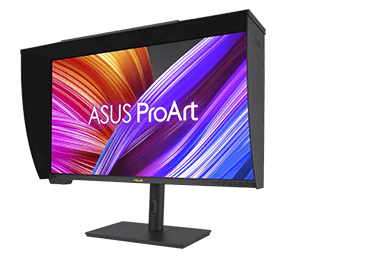
ProArt Display PA32UCXR

Get One with Limited Time Offer
- Asia-Pacific
- Africa & Middle East
- New Zealand
- Belgium / Français
- Belgium / Nederlands
- Czech Republic
- Netherlands
- United Kingdom
- Saudi Arabia
- United Arab Emirates / Arabic
- United Arab Emirates / English
Grand Upgrade Kit

Essentials for your workflow

Intel ® Core™ i9 processor 14900K ProArt Z790-Creator WiFi

Intel ® Core™ i7 processor 14700K ProArt B760-Creator WiFi

ProArt GeForce RTX 4070 Ti SUPER 16GB GDDR6X OC Edition

ProArt Display PA279CRV

ProArt Display PA169CDV
Enter “Create with the Best” Giveaway!
Campaign period:.
From 9 th April, 2024 – 21 st May, 2024 (Ending at 11:59 AM UTC+8)
How to Win:
- Complete one or more tasks on Gleam to enter the giveaway.
- The more you complete, the more chances you get to win amazing prizes.
- Win Bonus points by signing up for an ASUS membership and stay connected with us! Sign up NOW >>
Discover More
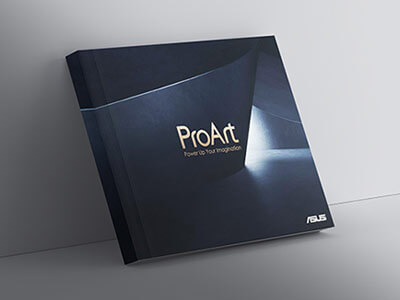
ProArt Brochure
Explore best-in-class professional products and solutions. Featuring the latest ProArt laptops, displays, motherboards and more.

Powered by ASUS for Content Creators
Find out more about custom PC solutions with world-class hardware

Explore more about next-gen computing power to enhance your AI workflow

ProArt Display Software & Tools
ProArt Displays are supported by free ProArt software tools designed to enhance productivity and easily maintain color accuracy across multiple ProArt monitors.
- Share full article
Advertisement
Subscriber-only Newsletter
Jessica Grose
Get tech out of the classroom before it’s too late.

By Jessica Grose
Opinion Writer
Jaime Lewis noticed that her eighth-grade son’s grades were slipping several months ago. She suspected it was because he was watching YouTube during class on his school-issued laptop, and her suspicions were validated. “I heard this from two of his teachers and confirmed with my son: Yes, he watches YouTube during class, and no, he doesn’t think he can stop. In fact, he opted out of retaking a math test he’d failed, just so he could watch YouTube,” she said.
She decided to do something about it. Lewis told me that she got together with other parents who were concerned about the unfettered use of school-sanctioned technology in San Luis Coastal Unified School District, their district in San Luis Obispo, Calif. Because they knew that it wasn’t realistic to ask for the removal of the laptops entirely, they went for what they saw as an achievable win: blocking YouTube from students’ devices. A few weeks ago, they had a meeting with the district superintendent and several other administrators, including the tech director.
To bolster their case, Lewis and her allies put together a video compilation of clips that elementary and middle school children had gotten past the district’s content filters.
Their video opens on images of nooses being fitted around the necks of the terrified women in the TV adaptation of “The Handmaid’s Tale.” It ends with the notoriously violent “Singin’ in the Rain” sequence from “A Clockwork Orange.” (Several versions of this scene are available on YouTube. The one she pointed me to included “rape scene” in the title.) Their video was part of a PowerPoint presentation filled with statements from other parents and school staff members, including one from a middle school assistant principal, who said, “I don’t know how often teachers are using YouTube in their curriculum.”
That acknowledgment gets to the heart of the problem with screens in schools. I heard from many parents who said that even when they asked district leaders how much time kids were spending on their screens, they couldn’t get straight answers; no one seemed to know, and no one seemed to be keeping track.
Eric Prater, the superintendent of the San Luis Coastal Unified School District, told me that he didn’t realize how much was getting through the schools’ content filters until Lewis and her fellow parents raised concerns. “Our tech department, as I found out from the meeting, spends quite a lot of time blocking certain websites,” he said. “It’s a quite time-consuming situation that I personally was not aware of.” He added that he’s grateful this was brought to his attention.
I don’t think educators are the bad guys here. Neither does Lewis. In general, educators want the best for students. The bad guys, as I see it, are tech companies.
One way or another, we’ve allowed Big Tech’s tentacles into absolutely every aspect of our children’s education, with very little oversight and no real proof that their devices or programs improve educational outcomes. Last year Collin Binkley at The Associated Press analyzed public records and found that “many of the largest school systems spent tens of millions of dollars in pandemic money on software and services from tech companies, including licenses for apps, games and tutoring websites.” However, he continued, schools “have little or no evidence the programs helped students.”
It’s not just waste, very likely, of taxpayer money that’s at issue. After reading many of the over 900 responses from parents and educators to my questionnaire about tech in schools and from the many conversations I had over the past few weeks with readers, I’m convinced that the downsides of tech in schools far outweigh the benefits.
Though tech’s incursion into America’s public schools — particularly our overreliance on devices — hyperaccelerated in 2020, it started well before the Covid-19 pandemic. Google, which provides the operating system for lower-cost Chromebooks and is owned by the same parent company as YouTube, is a big player in the school laptop space, though I also heard from many parents and teachers whose schools supply students with other types and brands of devices.
As my newsroom colleague Natasha Singer reported in 2017 (by which point “half the nation’s primary- and secondary-school students” were, according to Google, using its education apps), “Google makes $30 per device by selling management services for the millions of Chromebooks that ship to schools. But by habituating students to its offerings at a young age, Google obtains something much more valuable”: potential lifetime customers.
The issue goes beyond access to age-inappropriate clips or general distraction during school hours. Several parents related stories of even kindergartners reading almost exclusively on iPads because their school districts had phased out hard-copy books and writing materials after shifting to digital-only curriculums. There’s evidence that this is harmful: A 2019 analysis of the literature concluded that “readers may be more efficient and aware of their performance when reading from paper compared to screens.”
“It seems to be a constant battle between fighting for the students’ active attention (because their brains are now hard-wired for the instant gratification of TikTok and YouTube videos) and making sure they aren’t going to sites outside of the dozens they should be,” Nicole Post, who teaches at a public elementary school in Missouri, wrote to me. “It took months for students to listen to me tell a story or engage in a read-aloud. I’m distressed at the level of technology we’ve socialized them to believe is normal. I would give anything for a math or social studies textbook.”
I’ve heard about kids disregarding teachers who tried to limit tech use, fine motor skills atrophying because students rarely used pencils and children whose learning was ultimately stymied by the tech that initially helped them — for example, students learning English as a second language becoming too reliant on translation apps rather than becoming fluent.
Some teachers said they have programs that block certain sites and games, but those programs can be cumbersome. Some said they have software, like GoGuardian, that allows them to see the screens of all the students in their classes at once. But classroom time is zero sum: Teachers are either teaching or acting like prison wardens; they can’t do both at the same time.
Resources are finite. Software costs money . Replacing defunct or outdated laptops costs money . When it comes to I.T., many schools are understaffed . More of the money being spent on tech and the maintenance and training around the use of that tech could be spent on other things, like actual books. And badly monitored and used tech has the most potential for harm.
I’ve considered the counterarguments: Kids who’d be distracted by tech would find something else to distract them; K-12 students need to gain familiarity with tech to instill some vague work force readiness.
But on the first point, I think other forms of distraction — like talking to friends, doodling and daydreaming — are better than playing video games or watching YouTube because they at least involve children engaging with other children or their own minds. And there’s research that suggests laptops are uniquely distracting . One 2013 study found that even being next to a student who is multitasking on a computer can hurt a student’s test scores.
On the second point, you can have designated classes to teach children how to keyboard, code or use software that don’t require them to have laptops in their hands throughout the school day. And considering that various tech companies are developing artificial intelligence that, we’re meant to understand, will upend work as we know it , whatever tech skills we’re currently teaching will probably be obsolete by the time students enter the work force anyway. By then, it’ll be too late to claw back the brain space of our nation’s children that we’ve already ceded. And for what? So today’s grade schoolers can be really, really good at making PowerPoint presentations like the ones they might one day make as white-collar adults?
That’s the part that I can’t shake: We’ve let tech companies and their products set the terms of the argument about what education should be, and too many people, myself included, didn’t initially realize it. Companies never had to prove that devices or software, broadly speaking, helped students learn before those devices had wormed their way into America’s public schools. And now the onus is on parents to marshal arguments about the detriments of tech in schools.
Holly Coleman, a parent of two who lives in Kansas and is a substitute teacher in her district, describes what students are losing:
They can type quickly but struggle to write legibly. They can find info about any topic on the internet but can’t discuss that topic using recall, creativity or critical thinking. They can make a beautiful PowerPoint or Keynote in 20 minutes but can’t write a three-page paper or hand-make a poster board. Their textbooks are all online, which is great for the seams on their backpack, but tangible pages under your fingers literally connect you to the material you’re reading and learning. These kids do not know how to move through their day without a device in their hand and under their fingertips. They never even get the chance to disconnect from their tech and reconnect with one another through eye contact and conversation.
Jonathan Haidt’s new book, “The Anxious Generation: How the Great Rewiring of Childhood is Causing an Epidemic of Mental Illness,” prescribes phone-free schools as a way to remedy some of the challenges facing America’s children. I agree that there’s no place for smartphones on a K-12 campus. But if you take away the phones and the kids still have near-constant internet connectivity on devices they have with them in every class, the problem won’t go away.
When Covid hit and screens became the only way for millions of kids to “attend” school, not having a personal device became an equity issue. But we’re getting to a point where the opposite may be true. According to the responses to my questionnaire, during the remote-school era, private schools seemed to rely far less on screens than public schools, and many educators said that they deliberately chose lower-tech school environments for their own children — much the same way that some tech workers intentionally send their kids to screen-free schools.
We need to reframe the entire conversation around tech in schools because it’s far from clear that we’re getting the results we want as a society and because parents are in a defensive crouch, afraid to appear anti-progress or unwilling to prepare the next generation for the future. “I feel like a baby boomer attacking like this,” said Lewis.
But the drawbacks of constant screen time in schools go beyond data privacy, job security and whether a specific app increases math performance by a standard deviation. As Lewis put it, using tech in the classroom makes students “so passive, and it requires so little agency and initiative.” She added, “I’m very concerned about the species’ ability to survive and the ability to think critically and the importance of critical thinking outside of getting a job.”
If we don’t hit pause now and try to roll back some of the excesses, we’ll be doing our children — and society — a profound disservice.
The good news is that sometimes when the stakes become clear, educators respond: In May, Dr. Prater said, “we’re going to remove access to YouTube from our district devices for students.” He added that teachers will still be able to get access to YouTube if they want to show instructional videos. The district is also rethinking its phone policy to cut down on personal device use in the classroom. “For me,” he said, “it’s all about how do you find the common-sense approach, going forward, and match that up with good old-fashioned hands-on learning?” He knows technology can cause “a great deal of harm if we’re not careful.”
Jessica Grose is an Opinion writer for The Times, covering family, religion, education, culture and the way we live now.

COMMENTS
Who am I: Creative Essay. Who am I? This is a question that I should ask myself everyday, I consider myself as an individual person, with a body and a soul, a person who makes mistakes, laughs, cries, hurts, smiles, and loves. My life is full of meaningful relationships and memories. I am loved, supported, and encouraged by my family.
Here we got some fresh creative essay topics from our top college essay writer to make your choice easier: Explain an event in your life that spiraled out of control and flipped its course. Create a scenario that directs the end of the world. Camouflage the concept of love in a story that is completely irrelevant.
Examples. Example 1: Introduction to a Narrative Essay. Growing up near the sea, I always enjoyed going for an early evening walk down by the shore. It was not a beach, nor was it particularly warm, but it was quiet and secluded, with its craggy rocks lending the place a wild sort of air.
As you become familiar with creative writing tips, we'd like to share several amazing topic examples that might help you get out of writer's block: The enchanted garden tells a tale of blooms and whispers. Lost in time, a journey through historical echoes unfolds. Whispering winds unravel the secrets of nature.
1. Overusing adjectives and adverbs: While descriptive language is important in creative writing, overusing adjectives and adverbs can make your writing feel cluttered and overwhelming. 2. Using cliches and predictable plot lines: Creative writing is all about bringing something new and fresh to the table.
Write your ideas down and don't worry if they don't make sense. You can exclude and refine them later on in the editing phase. Read your draft and check that your ideas are stated in a chronological order that makes sense. Focus on the smooth transition that keeps your ideas clear, and your readers focused.
Do your best to draw in your reader right from the start. It's also essential to start as you mean to go on. A strong opening establishes the tone and sets the stage for the rest of the essay. If you begin with a captivating hook, be sure to stay consistent and match the tone throughout the whole piece of writing.
Step 2: Have a clear structure. Think about this while you're planning: your essay is like an argument or a speech. It needs to have a logical structure, with all your points coming together to answer the question. Start with the basics! It's best to choose a few major points which will become your main paragraphs.
1. Think about your reader. Chances are your teacher or examiner will have a lot to read - so keep them interested. With creative writing, as with any kind of writing, your reader is your most important consideration. You need to know and understand whom you're writing for if you're to do a good job of keeping them interested.
Features Of Creative Essays. Writers can express their creativity and artistic flare through creative essays. These pieces strive to enthrall readers with distinctive storytelling and emotional depth, going beyond simple facts and data. Let's examine the salient characteristics of creative essays: 1. Creativity
Find an original, creative way of starting your essay using the following two methods. Option 1: Start with an intriguing hook. Begin your essay with an unexpected statement to pique the reader's curiosity and compel them to carefully read your essay. A mysterious introduction disarms the reader's expectations and introduces questions that ...
Creative writing is writing meant to evoke emotion in a reader by communicating a theme. In storytelling (including literature, movies, graphic novels, creative nonfiction, and many video games), the theme is the central meaning the work communicates. Take the movie (and the novel upon which it's based) Jaws, for instance.
Come up with a thesis. Create an essay outline. Write the introduction. Write the main body, organized into paragraphs. Write the conclusion. Evaluate the overall organization. Revise the content of each paragraph. Proofread your essay or use a Grammar Checker for language errors. Use a plagiarism checker.
The next step in writing a creative essay is designing the body paragraphs. Each key point of your essay needs to be discussed in a separate paragraph. Start each paragraph with an opening sentence that explains what the readers are about to find out from the paragraph. Each point must be supported by strong evidence.
A creative essay is a type of writing where students express their imagination and artistic style. It involves creative storytelling techniques, not just stating mere facts. The aim is to engage the reader, often exploring emotions, personal experiences, or fictional narratives. Creative writing can be found in various types of papers ...
7. Art and Creativity. When people say creativity, they usually think about art because it involves imaginative and expressive actions. Art strongly indicates a person's ongoing effort and emotional power. To write this essay effectively, show how art relates to a person's creativity.
The first step to increasing creativity is to devote yourself to developing your creative abilities. Do not put off your efforts. Set goals, enlist the help of others, and put aside time each day to develop your skills. For example, if you are interested in painting, schedule time regularly to learn and practice your skills.
A metaphor is effective in any form of writing. In a creative essay writing, use an analogy to help provide the reader with a clear image. It should make them understand a concept you are explaining at a deeper level. Details are everything when writing creatively as they tug at the readers' emotions.
Write a creative essay about the plot from a movie you saw just before sleeping is coming to life. A stranger gives you an ominous-looking journal. You open it to investigate and discover…. A group of teenagers band together to fight an extraterrestrial threat. You stumble upon a strange house on your morning run.
Interactive example of a narrative essay. An example of a short narrative essay, responding to the prompt "Write about an experience where you learned something about yourself," is shown below. Hover over different parts of the text to see how the structure works. Narrative essay example.
The first stage of tackling creative essay ideas starts with creating a set-up. Here one should look to create a scene for the reader in which the main concept of the piece can be introduced without losing their interest. The best way to hook the audience is by having a compelling plotline and intriguing characters.
Check out this FREE essay on Am I Creative? ️ and use it to write your own unique paper. New York Essays - database with more than 65.000 college essays for A+ grades
i have been editing my creative map for 8 days in a row and i am still not eligible for enrolling in creative, can somebody please tell me what im doing wrong here. General. Tutorial & Course Discussions. fortnite, fortnite-creative, question. alkerixon (alkerixon_) April 14, 2024, 5:24am 1. image_2024-04-14_012240432 1049×543 128 KB ...
The basic structure of an essay always consists of an introduction, a body, and a conclusion. But for many students, the most difficult part of structuring an essay is deciding how to organize information within the body. This article provides useful templates and tips to help you outline your essay, make decisions about your structure, and ...
ProArt is a comprehensive ecosystem providing professional creators with a stable foundation for your inspiration. These custom workstations feature award-winning ProArt motherboards, graphics cards, CPU coolers and chassis, pairing with ProArt displays to accelerate your creative workflow and bring the boldest visions and ideas to life.
Opinion Writer. Jaime Lewis noticed that her eighth-grade son's grades were slipping several months ago. She suspected it was because he was watching YouTube during class on his school-issued ...